DESIGNING FOR BETTER MUSIC SHARING EXPERIENCE
Author: Zhujun Pang
z.pang@student.tue.nl
Date: 12 January 2023
Coach: Joep Frens j.w.frens@tue.nl
Second assessor: Steven Houben s.houben@tue.nl
Eindhoven University of Technology
Music Linker -M2.1 design project 1
Music Linker -M2.1 design project 09.2022-01.2023
People use music extensively in their daily lives. Although listening music is not essential for human survival, practically everyone appreciates the emotional benefits of doing so. As a means of expressing thoughts, sentiments, and emotions, music is another potent prosocial tool that can facilitate cross-cultural and linguistic communication as well as the development of strong emotional bonds [1].
As streaming music has grown in popularity, more and more people, particularly those in younger age groups, are eager to share music online. Music has become a tool for people to understand and communicate their tastes and values with each other. Sharing music helps people develop more intimate emotional bonds to some extent because people are more drawn to those who share their likes in music [10]. Studies have shown that sharing music can go a long way in bringing people closer together socially, as musical preferences can, to some extent, suggest a person's values and thus influence the social attraction between people [2]. Sharing music with others can help young people break the ice in social situations and deal with social issues to some level [15].
The Covid 19 outbreak has been ravaging the globe since the start of 2020 and has had a tremendous influence on people's daily lives and the world's political economy. The virus is still spreading today over many different nations. Online music consumption and distribution have significantly increased during this time, and music-related activities
have given people who are dealing with the impacts of the illness and the recession mental joy. Studies have revealed that engaging in music-related activities has a detrimental impact on emotions including anxiety, despair, and others. The unique qualities of music, which can communicate over linguistic and geographical distances, can also foster a sense of community despite physical separation. The sense of engagement gained through musical activities can be a good way to help people regulate their emotions and have a sense of social belonging [4].
In the second quarter of 2021, there were 523.9 million streaming customers worldwide [11]. The rise of music-related social activities has also been considerably boosted by the popularity of streaming music. The market for social entertainment in China, for instance, is expected to grow from its current projected $28.5 billion to $10.582 billion by 2025[20]. The aim of this design project is to first understand the needs and values of streaming music users in relation to the social communication properties of music through an empathetic approach, thereby proposing an innovative design solution to bring a better music sharing experience to users. The target audience for this design project is consumers in the millennial and Gen Z generations who are under 35 since they have a high demand for the social components of music and are generally willing to share it[3].
Music Linker -M2.1 design project Music Linker -M2.1 design project 2 3
INTRODUCTION 01 CONTENT 01 Introduction 2.1 Music sharing in streaming service 3.1 Methodology 4 3 6 8 9 11 10 14 16 18 19 20 24 28 42 30 44 40 45 41 47 48 52 54 50 5.1 Persona 5.3 Iteration 7.1 Methodology 2.2 Tangible preference in music experience 3.2 Findings 2.3 Missing gap 5.2 Ideation 5.4 Technical realization 7.2 Findings 7.3 Limitations 7.4 Discussions and future work 02 Related works 03 Explore the current music sharing flow 04 Design decision 05 Design process 06 Final design 07 User test & Evaluation Reference & Figure contents Appendix A - Individual reflection Appendix C - User test materials Appendix B - Mood board 08 Conclusion
02
RELATED WORKS
Much like the technologies used to play mu sic have evolved over time, so too have th e ways in which people share and converse about music. People used to collect vinyl records and CDs in the analogue era to demonstrate their musical preferences and personalities, as well as to socialize with one another by exchanging physical albums. Since the invention of portable music devices like MP3, people have started to listen to music with one another by lending the other half of their earphones. Following the advent of streaming music and the digital revolution, individuals have tended to use streaming music applications to enjoy and share music [21].
However, even with the dominance of streaming music in the global music market, physical music playback devices are still popular with many consumers. According to statistics, vinyl records were the most popular medium for physical music playback in 2020, with nearly 5 million copies sold, and the main purchasers contributing to these sales are young people under the age of 35 [22]. The physical medium requires a more laborious procedure than electronic playback devices, which can be readily controlled with a tap on the screen or a voice command, but people are still not ready to give up vinyl records and CD players. Much of a music experience that is dependent on hedonic consumption cannot be transmitted in a dematerialized form [23]. Touching an object can enhance the perception of the service, especially for objects with high aesthetic appeal, and tangibility can help foster a stronger
psychological bond between users and the associated service [9].
Therefore, during the desktop research phase, I will gather and analyze information in two areas.
1) THE DESIGN AND INTERACTION TECHNIQUES USED IN TODAY'S STREAMING MUSIC APPS TO SUPPORT MUSIC SHARING.
2) TANGIBILITY PREFERENCES AND PERCEPTIONS OF THE MUSIC EXPERIENCE.
By analyzing people's experiences of sharing music in the digital world, I hope to draw a current common interaction process used in popular streaming music platforms as a preliminary framework for this design project, thus, to identify where this process fails to meet user needs and needs to be optimized. In the second section of the analysis pertaining to the physical music experience, I intend to ascertain how the tangible product's physical features affect the user experience. Based on which I will investigate how these physical interaction elements can be employed to make up for a lack of experience in the electronic world in the ensuing design. These discoveries will ultimately aid in the development of an innovation for fusing the physicality of music-sharing interactions with streaming services to improve the user's music sharing experience.
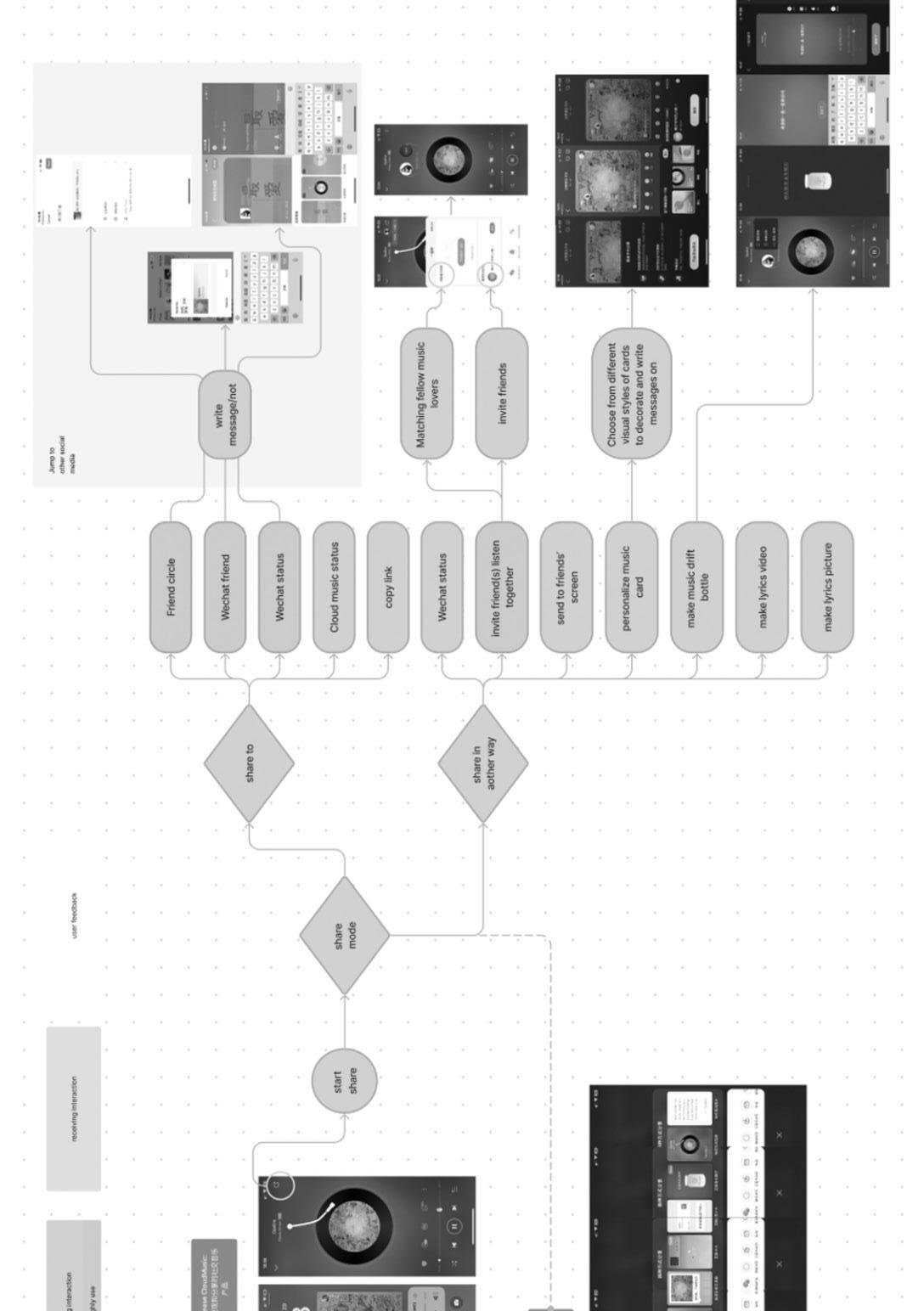
Music Linker -M2.1 design project 5
A number of streaming music platforms have already started to experiment with embedding social features, including Spotify, Apple Music and Last.fm. While most attempts to socialize streaming music
2.1 MUSIC SHARING IN STREAMING SERVICE SPOTIFY

As a pioneer of streaming music services in the social networking space, Spotify has been exploring the introduction of social features in music since a few years ago. In 2011/12, Spotify experimented with a social shift by creating profiles, adding friends and dragging and dropping music, and Facebook joined the Spotify dashboard as a partner to help show what friends were listening to and what was currently popular [5]. However, the Inbox/Messages feature was quietly phased out a few years ago due
have shown that it is not that easy to make it work, there is no doubt that social music sharing is an area that has a lot of potential and deserves more exploration to find the right direction.
to low usage. Figure 1 shows how Spotify used to share music messages within the web-based software. This failure does not mean that the music message sharing feature was not desired by users. From the user feedback collected from some current year users, it appears that the overall interface set-up makes it difficult for most users to discover or notice this feature, which might be the main reason for its low usage.
NETEASE CLOUD MUSIC
NetEase Cloud Music is one of the largest streaming music platforms in China. Its fantastic social features are the main factor that has allowed it to stand out in China's very competitive streaming music market. According to the software's creators, it is committed to creating a mobile music community for its customers. Currently, NetEase Cloud Music offers users a variety of options to share music, including sharing music to third-party social media platforms, sharing music to friends' mobile screens, adding music friends within the software, sending music messages and inviting
friends to listen to music at the same time, etc. Figure 3 illustrates how the main interface and procedure are organised. In 2022, NetEase Cloud Music even launched Mus, a music dating platform for strangers, but with the expansion of these social features and the sophistication of information about music social circles, more and more users began to think that the software was no longer pure.It appears that as music software, it has lost sight of its primary goal of disseminating and sharing music [24].
Although initial attempts to share music messages within the app were unsuccessful, Spotify is still actively exploring other aspects of music social applications. Currently, the main music sharing interaction flow on Spotify mobile can be summarized as shown in Figure 2. When a user wants to share a music message, they need to jump from Spotify to the social media app associated with it or copy the link and paste it to a friend through another channel.

In addition to this, Spotify is exploring a new social direction in music with the introduction of Group Sessions in 2020, which will allow advanced users to share playlists with friends and even listen to and control music playback at the same time. In particular, the "Spotify Wrapped Campaign" at the end of each year since 2016 has also shown great success. In 2020, more than 90 million users worldwide were actively using this fun feature to showcase their music habits and tastes and communicate with their friends [18].

Music Linker -M2.1 design project Music Linker -M2.1 design project 6 7
Fig.1 Spotify inbox chat (https://routenote.com/blog/spotify-are-getting-rid-of-their-inbox-and-messaging-features/)
Fig.2 Spotify music sharing flow
Fig.3 Netease Cloud Music music sharing flow
As a complement to the analysis of the online profiles, I have collected screenshots of the different types of music sharing from personal social media accounts for analysis, including feedback from both parties involved in the sharing process, as shown in Figure 4, where all the identity information involved has been blurred. It can be seen

that shares that present a nice album cover and basic information about the song tend to be more attractive to the person who shares it than shares that are linked or tell the song title directly, thus increasing the probability of the share being opened and receiving more feedback.
music world is gradually being lost, and more and more researchers are looking into the connection between materiality and the musical experience. Studies have shown that people's preference for tangibles is positively correlated with music engagement [14]. Engagement is an important factor influencing consumer attitudes, behavior and decision perceptions. Particularly in hedonic consumer products that focus on aesthetics and subjective experience, user engagement tends to stimulate more emotional engagement [6]. Skågeby uses the example of cassette tapes to argue that
2.3 MISSING GAP
physical attributes such as the size of the object provide real aesthetic value[12] and Magaudda explains how the materiality of music can help shape valuable listening habits by comparing the iPod, the external hard drive and the vinyl disc[7]. In addition, research has also begun to explore how the physical properties of the physical music medium can be combined with streaming music to create a better musical experience, with Choi and Ha yeon investigating how weighty physical interactive elements can be applied to the electronic music world by designing a model called MuScale[25].
2.2 TANGIBLE PREFERENCE IN MUSIC
EXPERIENCE
The rapid progress of digital revolution brings the trend of dematerialization. It is used to describe the trend towards the replacement of more and more physical products with electronic information[26].
With the dematerialization of the musical experience brought about by the development of streaming music, people are beginning to realize that some of the sense of experience unique to the physical
An analysis of the social properties and sharing interaction processes of Spotify and NetEase Cloud Music, two of the marketleading streaming music applications, reveals that exploring the social aspects of music is not an easy task. Designers from all over the world are constantly trying to create services and designs that allow users to share music better. However, in practice, the combination of music and social interaction often causes different levels of conflict due to different user engagement purposes, usage habits, strategic goals, and design features of the software itself.
THE CONFLICT BETWEEN USERS' PURE DESIRE TO COMMUNICATE MUSIC AND THE CONVERGENCE OF STREAMING PLATFORMS TOWARDS SOCIAL MEDIA APPLICATIONS IN ORDER TO ATTRACT USERS IS EMERGING [16].
Therefore, in order to develop a design that improves the experience of sharing
music, the project must first strike a balance between the importance of the social and musical elements, placing a strong emphasis on assisting users in better understanding and communicating music while avoiding overburdening them with social cues. Second, as people typically choose attractive ways of delivering music, it is also crucial to think about how to make the shared information conveyed more appealing.
At the same time, the project will attempt to create a physical product to support the music sharing experience, relying on the basic functions of streaming music platforms. The physical medium of a music player has a timeless appeal to people. It provides a sense of ritual and a deeper emotional connection to the process of sharing through touch, while streaming services provide easy access to a vast library of music. The combination of the two can help us better enjoy and communicate music in the twenty-first century.
Music Linker -M2.1 design project Music Linker -M2.1 design project 8 9
Fig.4 Feedback collection
03
EXPLORE THE CURRENT MUSIC SHARING FLOW
In order to better explore users' scenarios and needs for enjoying and sharing music in their daily lives, I invited six young people to conduct semi-structured user interviews and collected photographs of their usual music listening places and audio equipment. All data from images and audio files from
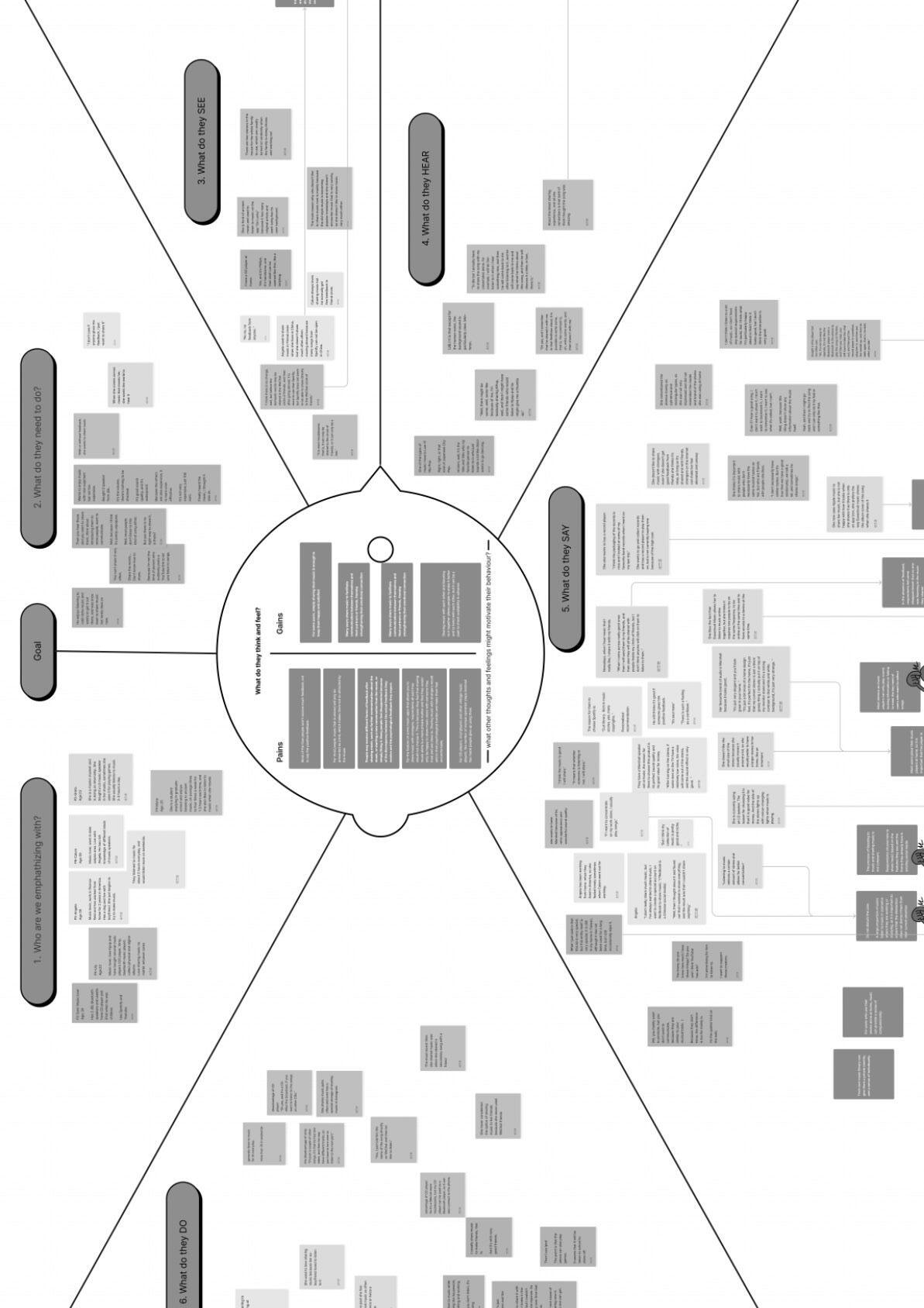
3.1 METHODOLOGY Participants
Six young people aged between 22 and 29 were interviewed for approximately 20–30 minutes each, two of whom were in a relationship and therefore were interviewed together. The interviews focused on three main areas of inquiry.
1) Users' motivations for sharing music and the feedback they expect from this process
2) The specific actions users take to share music and what they think at different stages of the process
3) What technical or behavioural barriers exist in current music-sharing interaction processes, and what factors may discourage the party from sharing or being shared music?
Considering that the subsequent design direction was mainly physical product design, questions related to the perception of using physical music playing devices
interviews were shared with participants and consent was sought before testing. Interviews were done in compliance with the Ethical Review Board (ERB) , which is a general regulation belongs to Industrial Design department.
were also included in the interviews. The basic information of the interviewees is shown in Table 1, and the relevant interview questions can be found in Appendix B.
The in-depth user interviews provided me with a wealth of information about each interviewee's music, life, and even emotional connections. In order to analyze this information, I first chose to extract the key messages from the transcripts and created post-it notes to summarize them, which is shown in the Figure 5.
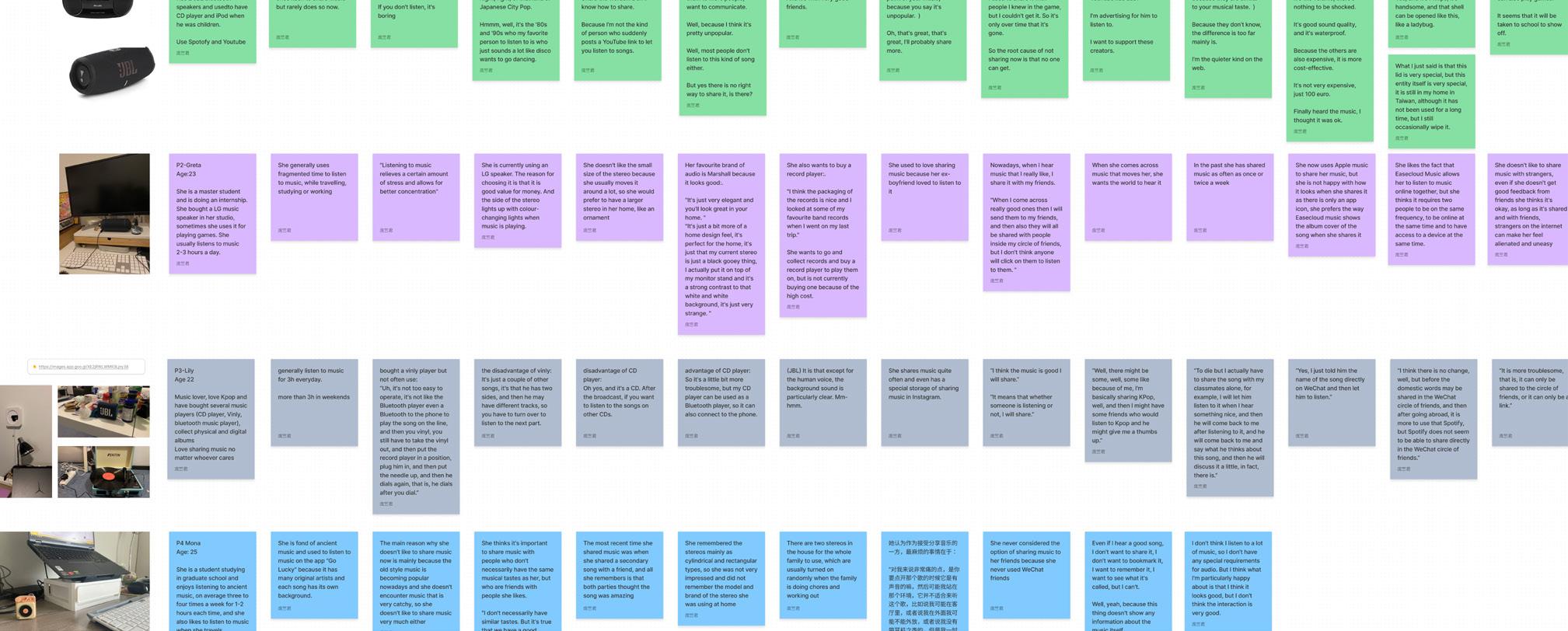
Music Linker -M2.1 design project 11
ID Age Gender P1 24 Male P2 23 Female P3 22 Female P4 25 Female P5 29 Female P6 29 Male
Analysis
Table.1
Fig.5
Empathy map
"Empathy" is the ability to understand and share the feelings of others. For people in all sectors, including designers, empathy can help them better empathize with the feelings of others and thus uncover the deeper needs of users[13]. In order to explore the needs and feelings of my target users in more depth, I chose to adopt the method of creating the Empathy Map by categorizing the content of sticky notes according to their actions, words, feelings, and thoughts. This allows me to gain a deeper understanding of the user's behaviours and feelings and minimize my own subjective ideas as a designer. Sometimes there are
discrepancies between what people say and what they do, which are indeed caused by people's inner needs. The content of the Empathy Map is shown in Figure 6.
Create User Interaction Flow of sharing music
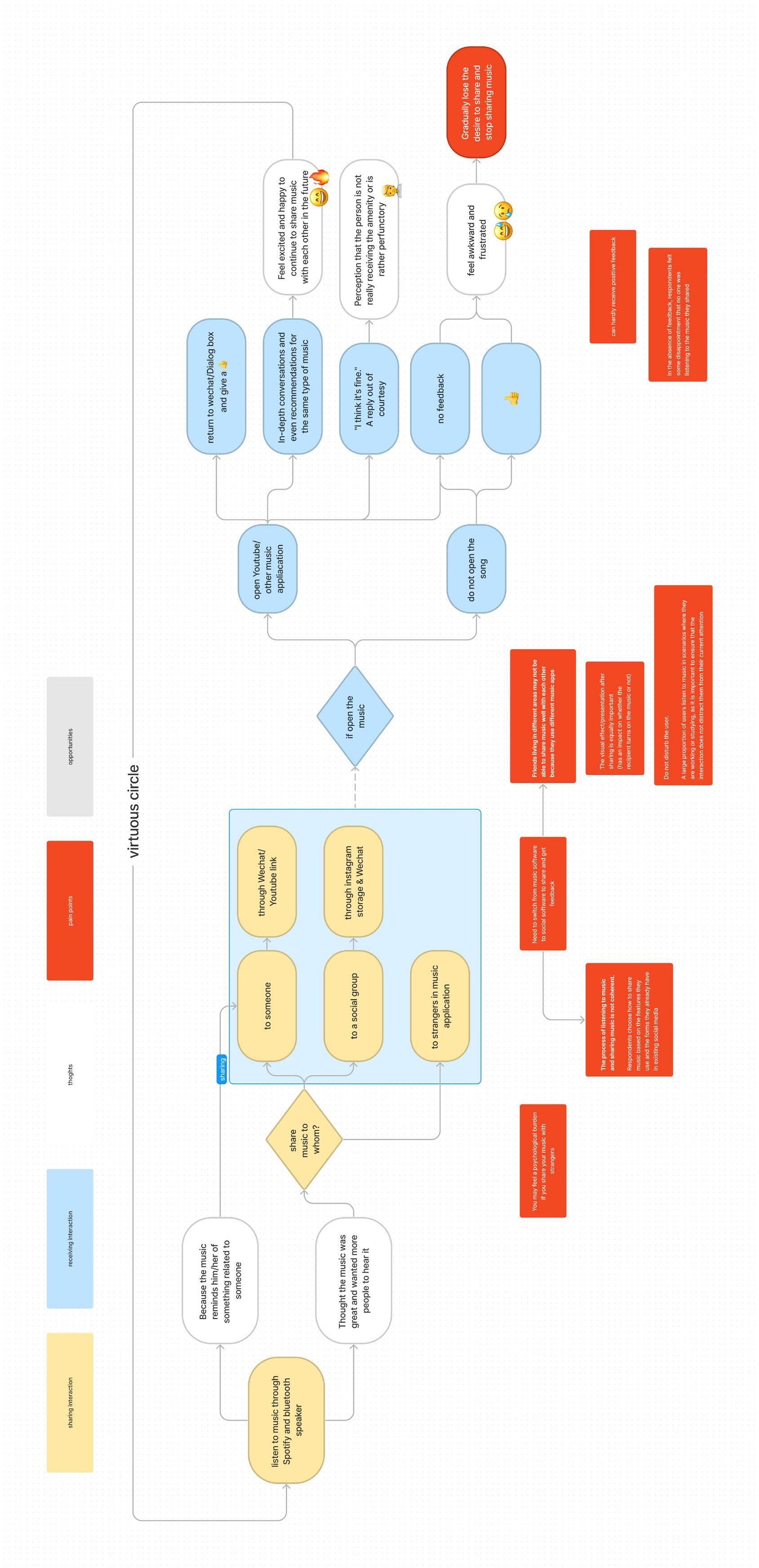
In order to have a more intuitive and complete understanding of the existing user experience of sharing music, based on the content of the user interviews and the Empathy map created, I have summarized the general flow of how users currently share music and the different situations that may occur, as shown in Figure 7.
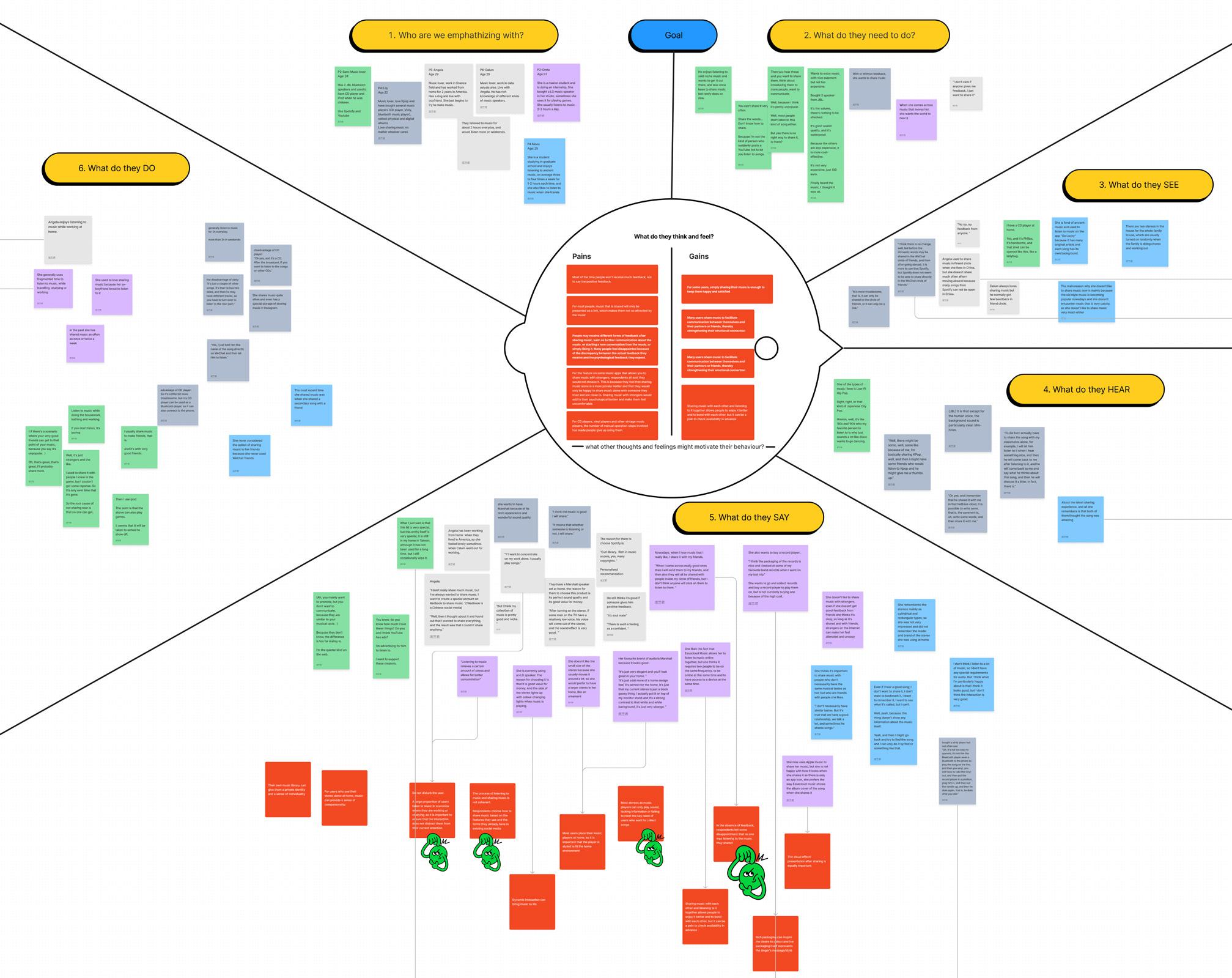
Music Linker -M2.1 design project Music Linker -M2.1 design project 12 13
Fig.6 Empathy Map Fig.7 Interaction flow
3.2 FINDINGS
The empathy map and current user interaction flow of sharing music resulted in 5 general themes.
Motivations for music sharing
Many people's actions to share music are driven by their desire to share. All six of the young people interviewed expressed a desire to share music, and even though some of them had gradually started to share less music, the desire to share had not been lost. Some of the interviewees said that sharing their favourite music and various related things made them happy and that they did not particularly care about the outcome of sharing, but rather enjoyed the process of sharing. For example, P6 said, "I don't care if anyone gives me feedback, I just want to share it."
Sharing and receiving feedback on music
People may receive different forms of feedback after sharing music, such as further communication about the music, starting a new conversation about the music, or simply giving a "heart" or "thumbs up." Many people feel disappointed because of the discrepancy between the actual feedback they receive and the psychological feedback they expect. Some users expect more insight or deeper communication about the topic, but often receive perfunctory responses. They may feel frustrated or even cut back on sharing music because they are afraid they won't receive the feedback they were expecting. Some users simply want to share their music and are happy enough to know that the receivers have heard it, or that a simple "like" is enough for them.
Ways of presenting the music message
Several interviewees stated that when
they were the ones being shared a piece of music, the manner in which the music was presented may have played a role in whether people opened this music message. P2 says she prefers to click on the songs her friends share on NetEase Cloud Music because it has a nice electronic album cover with the song and artist names. In contrast, Apple Music's sharing with only the app's icon is bland and uninspiring, as is the text-based web link that results from YouTube sharing. In particular, all respondents mentioned that they had to switch to third-party social media software when sharing music, due to the limitations of the current mainstream music software. The problem with this form of sharing, however, is that it is inconvenient for the person being shared when they are in a meeting, at school, or in any situation where it is not convenient for them to check their music messages. P4 said, "The very painful point for me is that when you click on that song, it has good sound, and then maybe I'm standing in that environment and it's not suitable to listen to that song, like I might be in the living room, or I might be outside, and I might not be able to play it out, or I don't have my headphones on, or something like that, but I just don't want to listen to that song for a while. ”
A sense of fragmentation in the music sharing process
It is evident from the current interaction flow of how users commonly share music that there is not a coherent transition between enjoying music and sharing it. When people hear a great song that they want to share, they have to switch from the music application to a third-party social media platform to do so, and the sharer has to make multiple page hops in the process. For the recipient of the shared music, they often have to click on it, jump to the thirdparty music software, confirm it, and then
return to the social media platform when they have finished listening to the music and want to give feedback.
Musical engagement and physicality
One of the interesting things was that most interviewees expressed a preference for vintage music players and related physical products, but they also said they didn't use them very often. People often like to use and display vintage music players when they just get them, and many participants wished to get gorgeous and special vinyl records as memorable gifts. However, the tedious steps involved can gradually put them off using these products again and again. "It's not too easy to operate; it's not like the Bluetooth player, even a Bluetooth to the phone to play the song on the line, and then you have to take the vinyl out, and then put the record player in a position, plug him in, and then put the needle up, and then he dials again, that is, he dials after you dial," P1 explained.
Music Linker -M2.1 design project Music Linker -M2.1 design project 14 15
04
DESIGN DECISION
THE ANALYSIS OF THE PREVIOUS DESKTOP RESEARCH AND USER STUDIES PROVIDED A SOLID FOUNDATION FOR MY DESIGN WORK IN THE AREA OF MUSIC SHARING. FOR THIS DESIGN PROJECT, I DECIDED TO WORK IN THREE MAIN DIRECTIONS.
1) IMPROVING THE WAY SHARED MUSIC INFORMATION IS PRESENTED.
The user study's findings make it abundantly evident how important it is to display shared musical information. The sender of the song assumes that the recipient would listen to it, and the recipient might also anticipate the message to be a pleasurable experience and a surprise to themselves. For the person being shared, an attractive music message increases the likelihood that they will open the music. At the same time, due to the audible nature of music, the message should be presented in an appropriate way so as not to disturb the person being shared.
Therefore, the shared music message should be delivered gently to inform the sharer while yet being intriguing enough to pique their interest.
2) BRIDGING THE GAP BETWEEN ENJOYING MUSIC AND SHARING MUSIC.
Currently, popular streaming apps generally require users to switch between social networking software when sharing music and receiving music information, which is inconvenient for both parties sharing music to a certain extent. However, some apps with a social focus on music are overexploited with social features that add to the browsing and usage burden of users.
This project aims to return to the original concept of music socializing, creating social features that are moderate and smoothly connected to the music itself to help users share and communicate better.
3) INTEGRATING THE PHYSICAL INTERACTION FEATURES WITH THE ADVANTAGES OF STREAMING MUSIC.
Streaming platforms can provide users with a convenient and easy way to access a huge music catalogue. This design will attempt to create upon the streaming music application and design an accompanying music sharing service for it. Preliminary research has shown the impact of tangible features on the hedonic consumption experience and the engagement with the music experience, particularly in facilitating an emotional connection between the user and the service recipient. As a result, this project's design prioritises the exploration of interactive strategies for physical music sharing, with the associated streaming service component serving as background assistance.
In particular, beyond these three design themes, I expected to use the artifacts from this project to explore how to provide users with appropriate feedback mechanisms during the music sharing process. The results of the user interviews show that each user has different expectations for the quality of feedback, and that the difference between the expected and actual feedback is a major disincentive to sharing music. Therefore, creating appropriate feedback mechanisms for users is an important part of building a suitable music sharing service. In this project, I will remove this feature and further investigate the need for a feedback mechanism in the music sharing process through the feedback generated by subsequent users using the product prototype, as well as finding out what kind of feedback is appropriate for the majority of users through their own requests.
Music Linker -M2.1 design project Music Linker -M2.1 design project 16 17
5.1 PERSONA
Creating a persona can help designers better define the scenarios for a product or service from the perspective of the target users [17]. Based on the findings from the user interviews, I constraucted a user portrait of Anna, a data analyst who lives
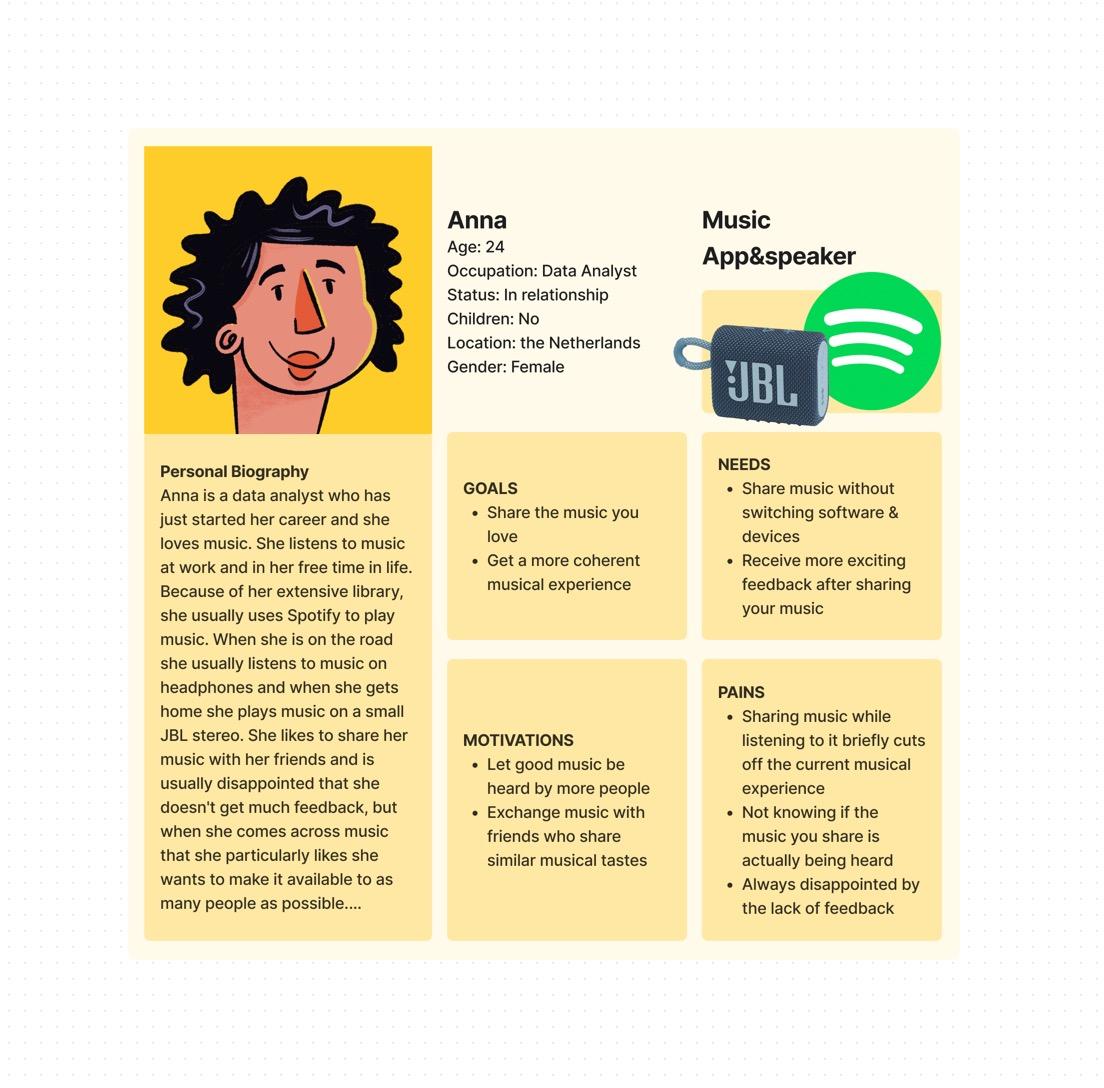
she was an adolescent, to further define the needs and values of the target group. The persona is shown in figure 8. In recent years, she has been sharing less and less music with her friends. She still has a strong desire to share but feels embarrassed

DESIGN PROCESS 05
Fig.8 Persona
5.2 IDEATION
Firstly, I envisioned the musical life of the virtual user Anna and imagined the various situations she might encounter in the actual music sharing scenario. Combining the analysis of the previous studies, I designed a new interaction flow as a framework for sharing and receiving music information as the basic structure for conceptualizing the subsequent design solution. The specific interaction flow is shown in Figure 9. During this design process, I identified a
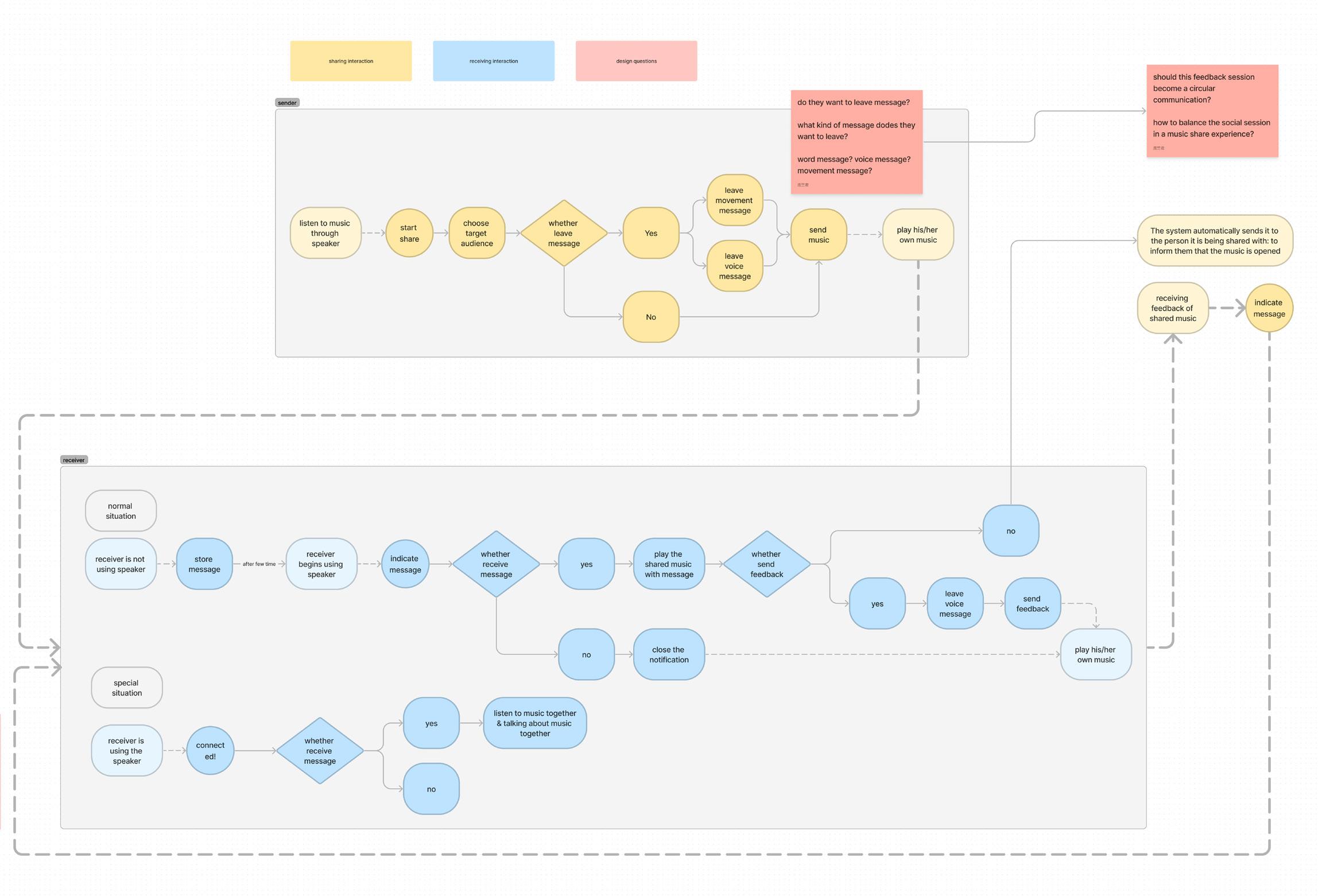
number of interaction points where there was strong uncertainty in the design. For example, I could not know whether users would need feedback, whether users would need to send their thoughts while sharing music information, whether a loopable feedback mechanism would lead to an over-socialization of the product, and which kind of interaction for communicating would be more interesting for the user, verbally or through movement.
Next, I used brainstorming to get more specific with my ideas. I firstly made a Mood board by collecting many pictures that could be linked to music and the sense of connection (Seen in Appendix C). Then I made a number of quick sketches to spread the inspiration. These solutions were based on the three design decisions summarized above. All of the design solutions use the physical product as the vehicle for interaction, while the music library is built on a streaming service. Ultimately, I have grouped all the designs that emerged from the brainstorming into two main categories.
1) AN INTEGRATED DESIGN FOR A STEREO WITH THE ABILITY TO SHARE AND COMMUNICATE MUSIC
2) AN ACCESSORY TO THE STEREO, DESIGNED TO COMPLEMENT THE MUSIC PLAYER THAT THE USER OWNS TO SHARE MUSIC.
Considering this project as an initial experiment in the physical design of a shared music process, I decided to adopt the second design direction. As the speaker accessory is smaller in size and more focused on the sharing of music itself from a product design perspective, it was more suitable as a stepping stone to physical music sharing design in the initial exploratory phase.
In order to choose a better solution for further development, I asked my coach , Professor Joep Frens, and four design students to discuss the numerous design solutions created by the brainstorming process separately. In the end, I chose to use the vintage telephone handset and the paper cup sound transmission as inspiration to distill the abstract interaction and physical form. These two objects provide a sense of connection, a sense of ritual, a retro feel that many young people aspire to in modern times, and a perception that is barely different for users from different countries.
Music Linker -M2.1 design project Music Linker -M2.1 design project 20 21
A SPEAKER WITH MUSIC
SHARE FUNCTION
SPEAKER ACCESSORY TO HELP SHARE MUSIC
Fig.9
Fig.10,16,17,19 - Old telephone and paper cup inspiration
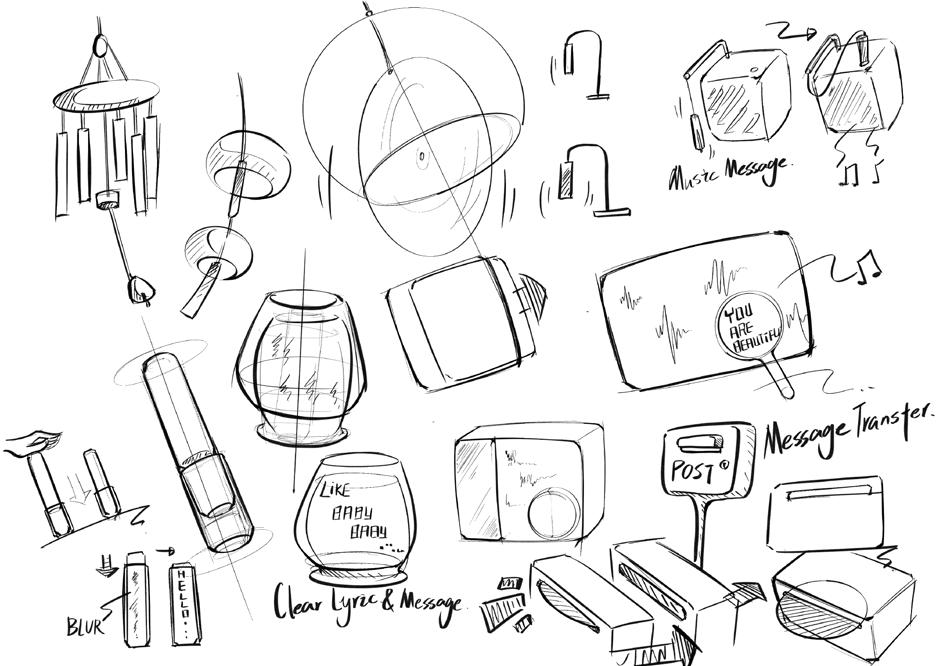
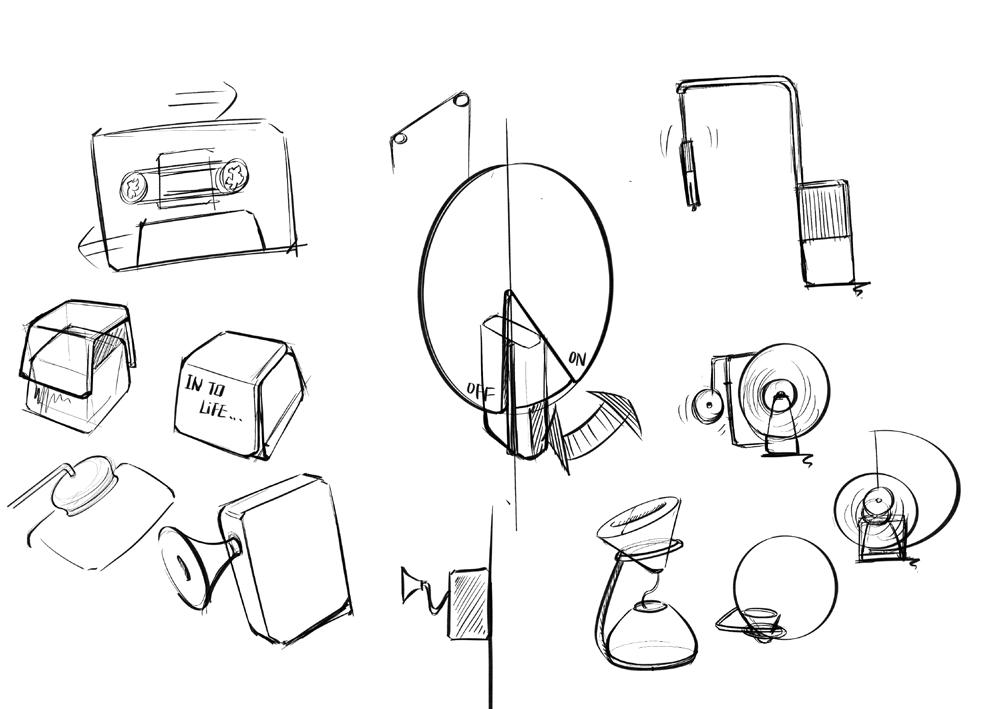
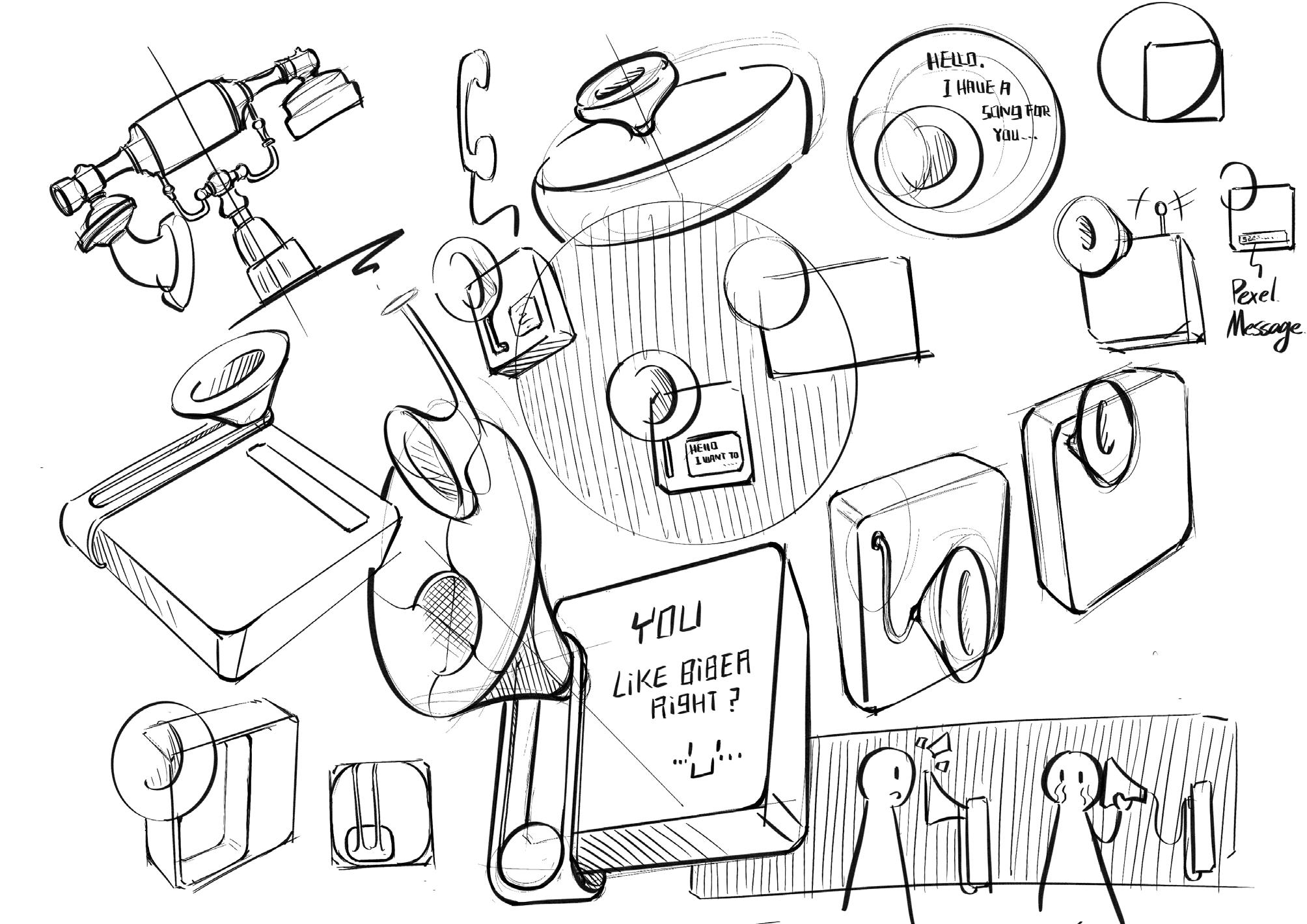
Fig.11,15 - Flower inspiration
Fig.12,13 - Vinly inspiration
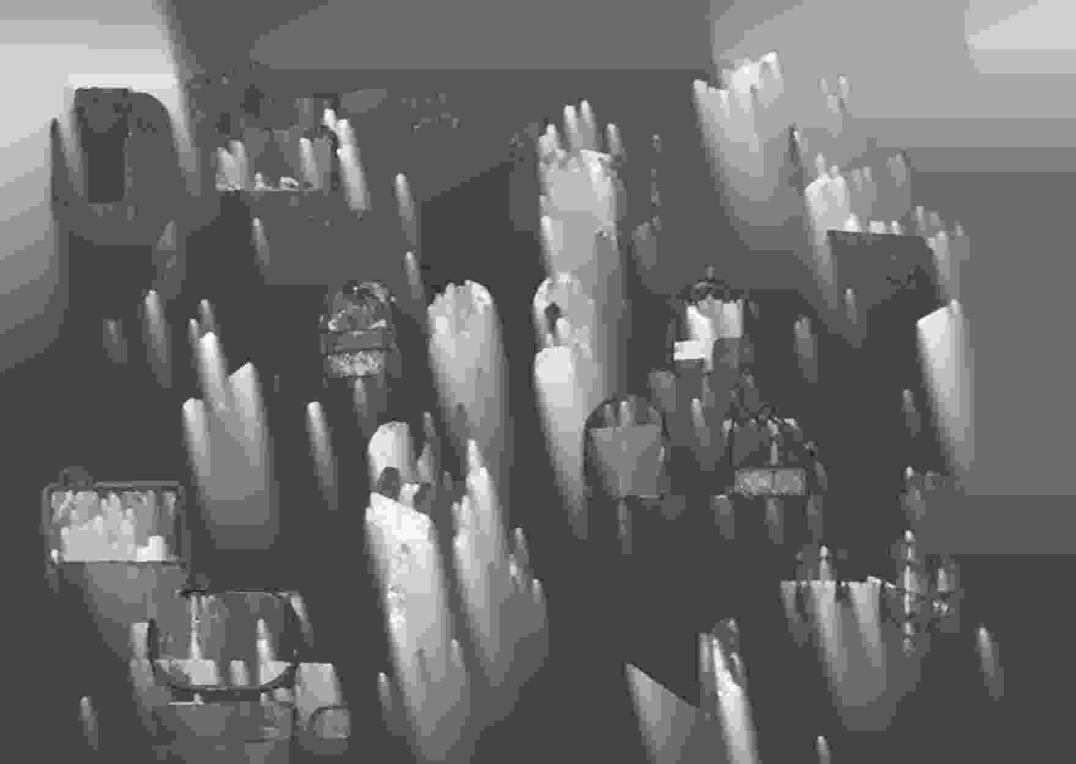
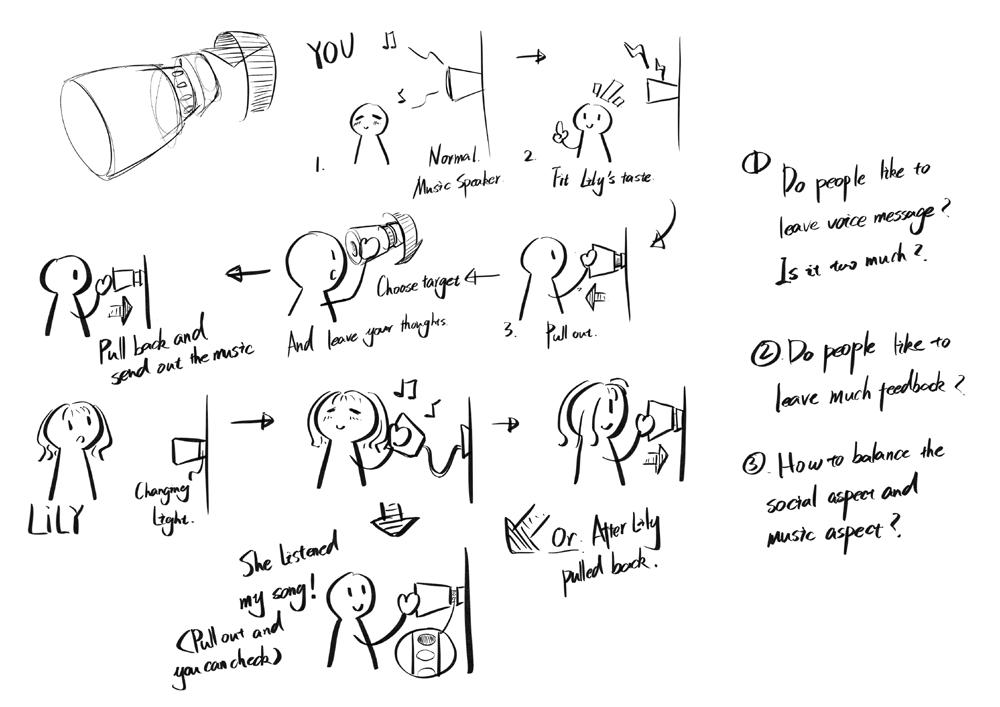
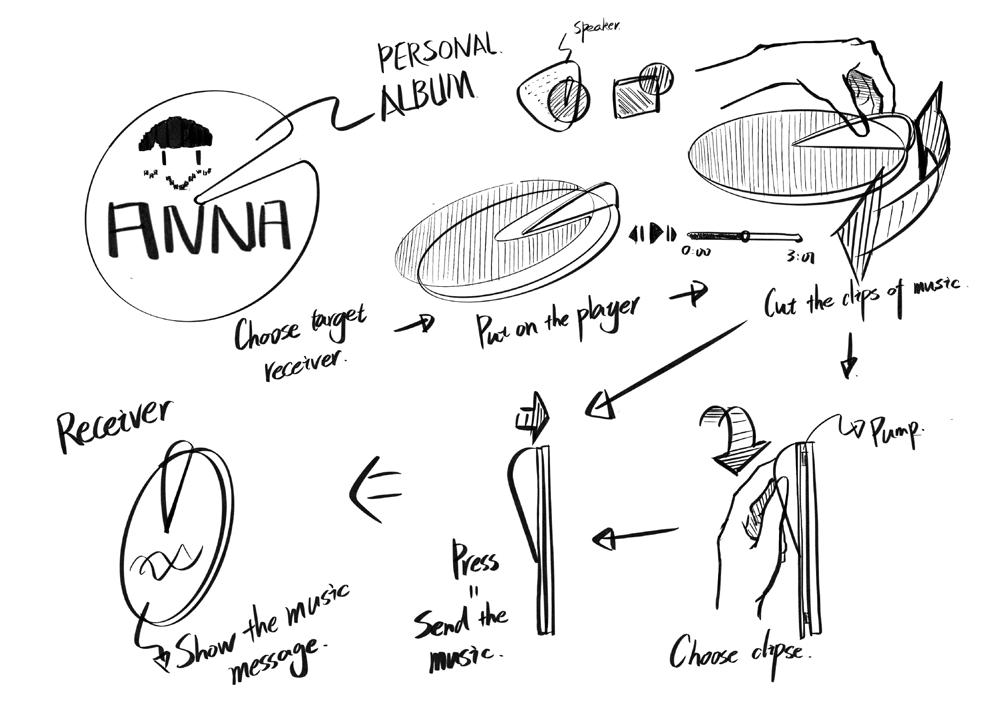
Fig.19 - Wind chimes inspiration



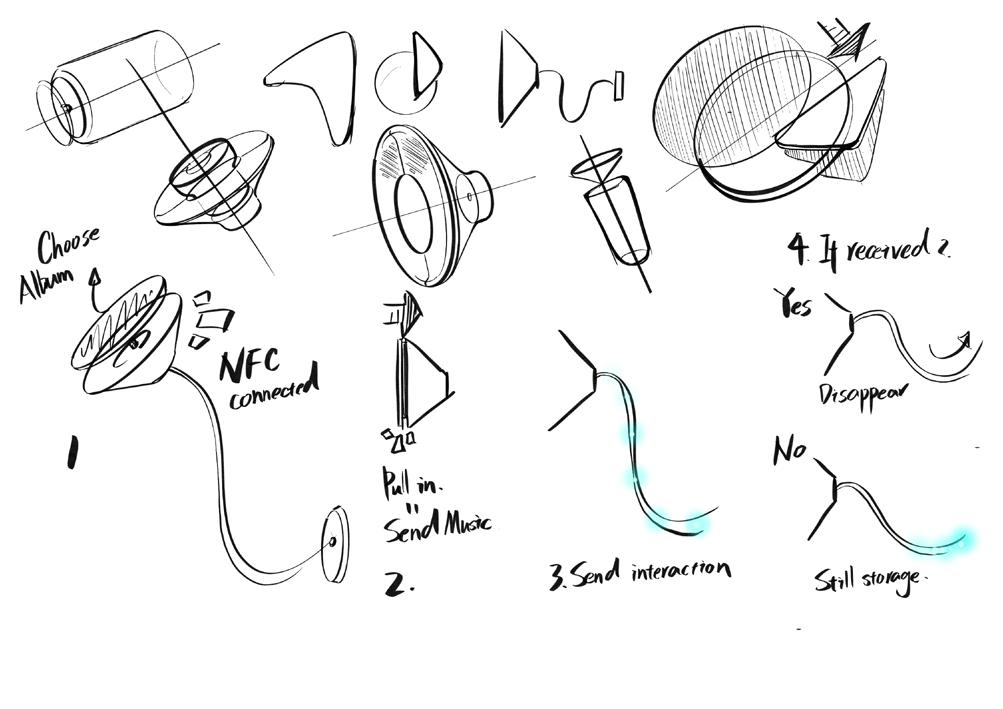
Music Linker -M2.1 design project Music Linker -M2.1 design project 22 23
Fig.10
Fig.12
Fig.16
Fig.13
Fig.17
Fig.14
Fig.18
Fig.15
Fig.19
Fig.11
5.3 ITERATION
To further define the shape of the product and the form of the interaction, I first made a few simple models out of cardboard to initially determine the size of the product for placement in a common user scenario and for gripping. As is seen in Figure 20. I then chose to use the feature from the retro telephone rotary dial to design an interaction to select target audiences from the address book to share. In order to create a better physical interface for this interaction, I chose to create some 2D
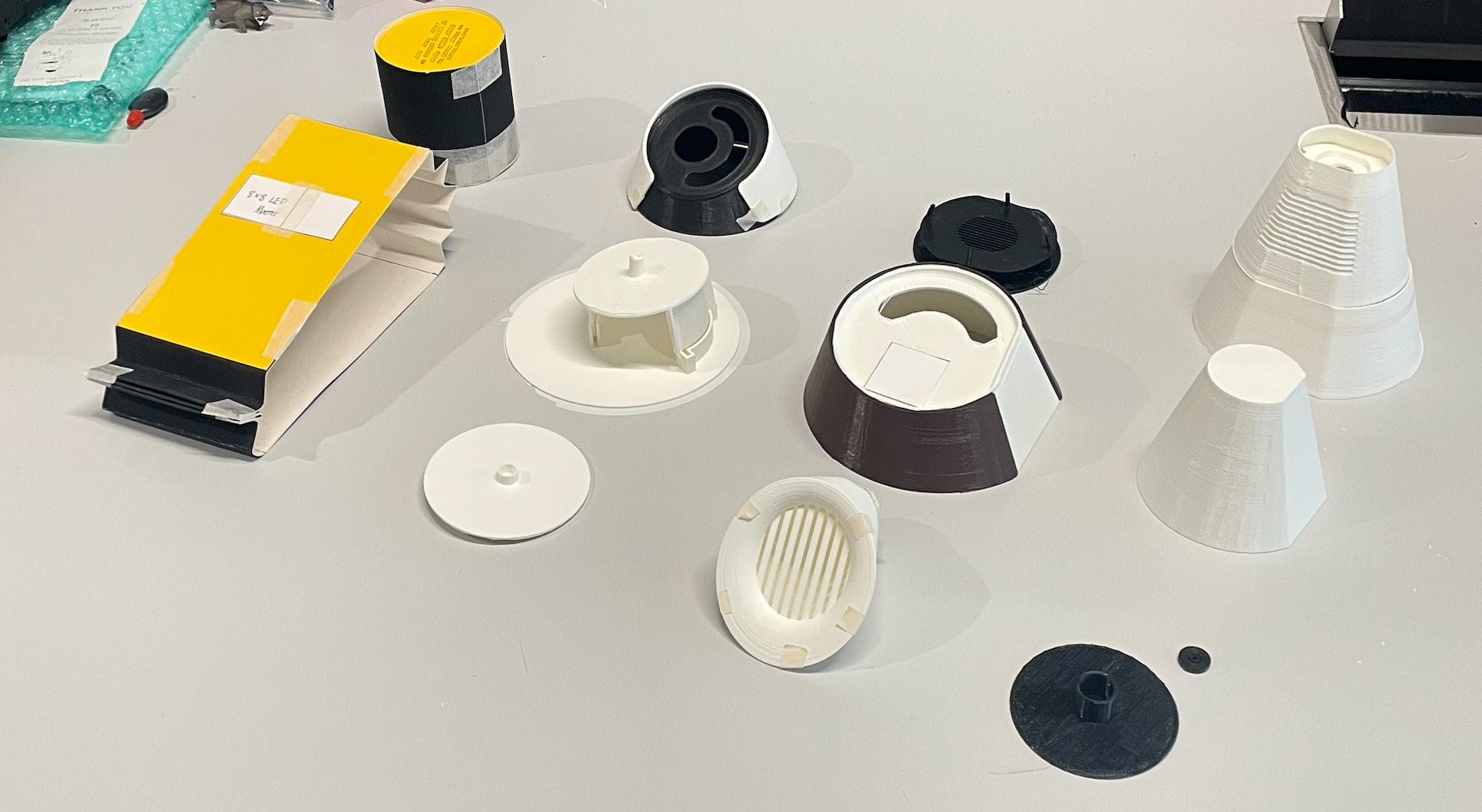
designs in Illustrator to refine the interaction screen, and print out some low-fidelity prototypes quickly through modeling and 3D printing techniques to test. During this process, I sketched and modeled a number of 3D-printed models based on how they felt in use and their actual visualization, and then 3D printed them in a continuous iterative process. They can be seen in Figure 21 and 22.The final refined sketches from this process are shown in Figure 23.
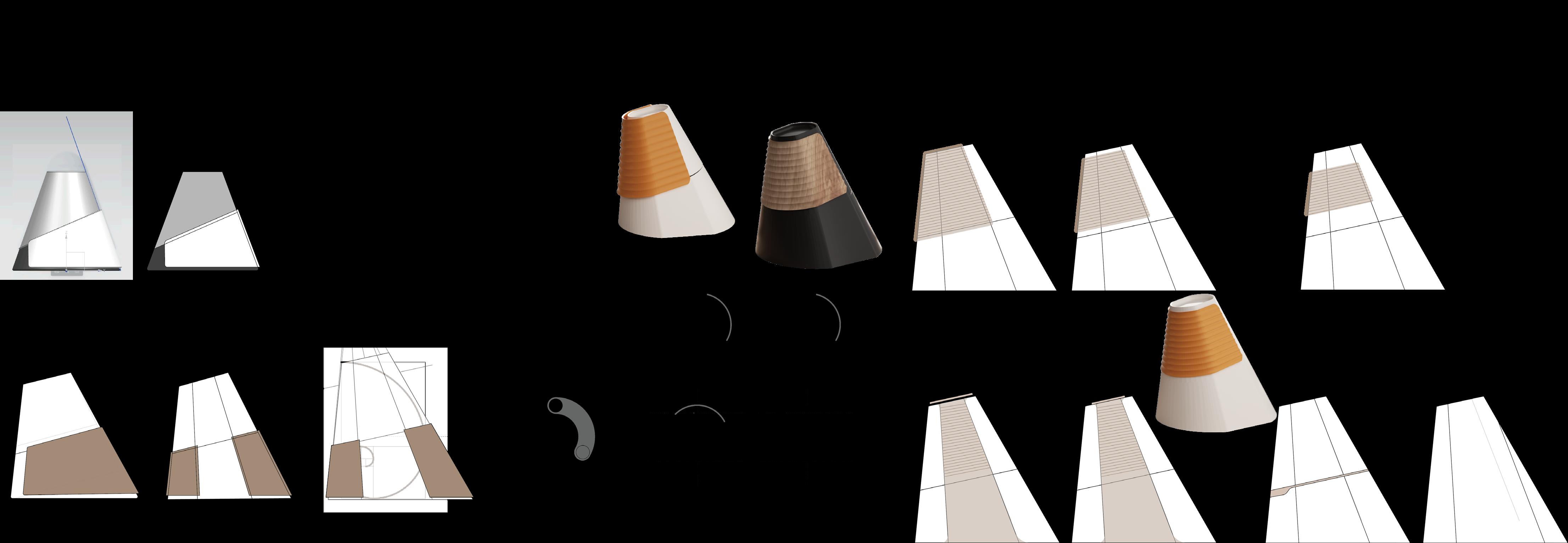
Music Linker -M2.1 design project Music Linker -M2.1 design project 24 25
Fig.20
Fig.21



Music Linker -M2.1 design project Music Linker -M2.1 design project 26 27 Fig. 22
Fig. 23
5.4 TECHNICAL REALIZATION
During the physical prototyping phase, I wanted to implement as many of the interactive features of the final design concept as possible for better user testing. The overall prototype was modeled and then produced using 3D printing technology, and adjustments such as sanding, and cutting were made for better presentation.
Depending on the availability of electronic components and familiarity with my programming skills, some design features were slightly adjusted in appearance. The final design is physically divided into two main parts, the top and bottom.

The top half of the structure, from top to bottom, is made up of a button that the user presses to pair and connect to the phone via Bluetooth when the product is first initialized, an LED strip to remind the user that a music sharing message has been delivered, a speaker and amplifier to play the sound, and a spiral coil that connects the wires from the button, LED strip, and audio components to the ESP 8266 chip in the bottom half for circuit control and power supply.
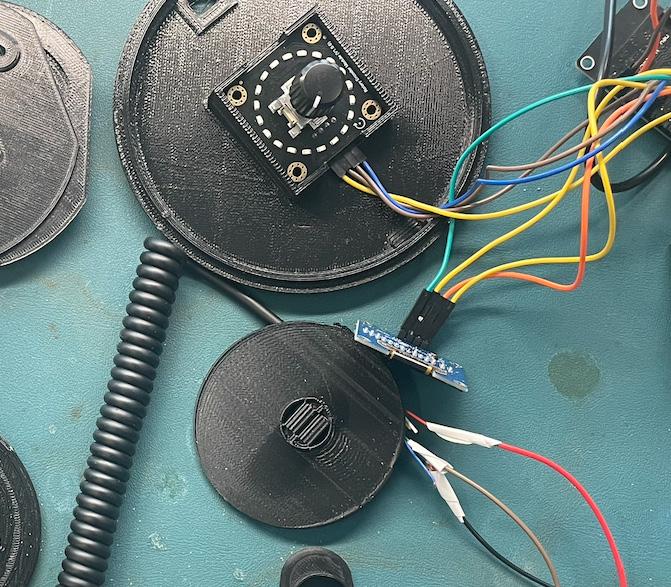
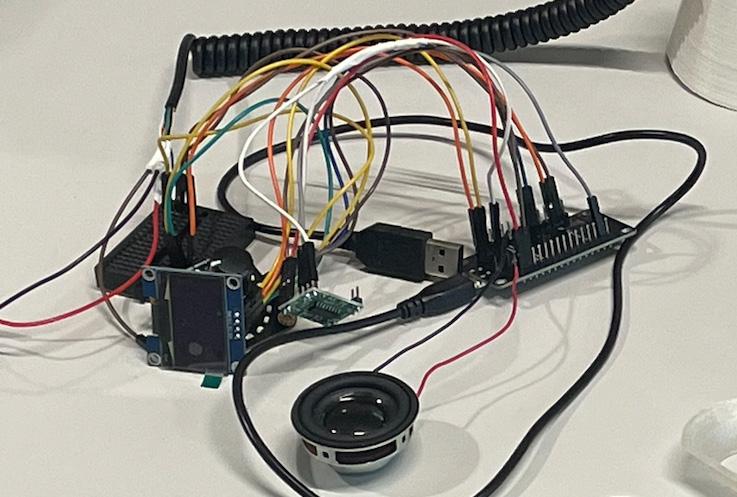
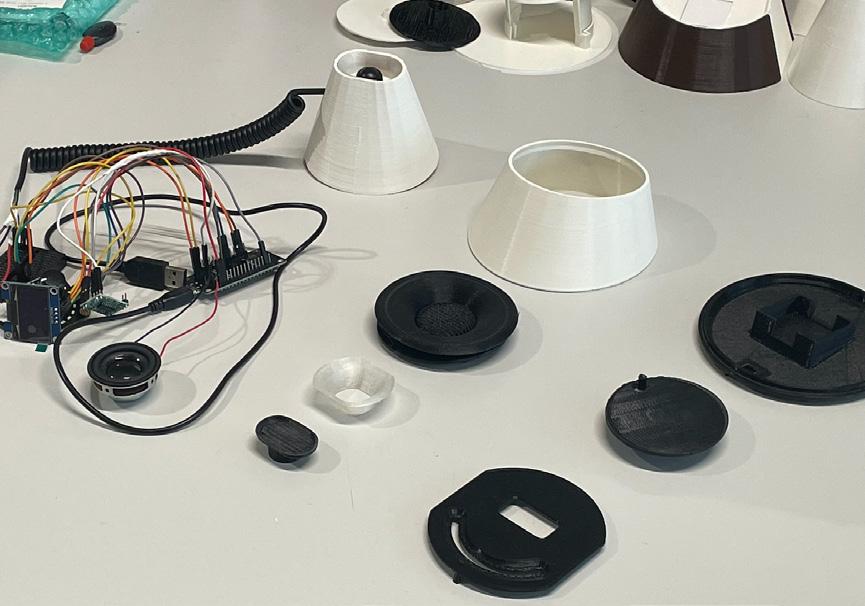
The bottom half of the structure, from top to bottom, is: the screen, which displays

the names stored in the phone's music sharing contact; the rotary button, which controls the switching of the selected music sharing recipient as the user rotates the button along the slide, and sends it to the current recipient when the button is pressed, at which point the screen will also display "Sent" to alert the user. The ESP 8266, which is connected to the power supply to power the entire circuit, controls the connection of the internal circuit between the rotary button and the screen, as well as the LED strip and audio components in the upper part.

Music Linker -M2.1 design project Music Linker -M2.1 design project 28 29
Button
RS PROLED strip
Speaker driver
Rotary encoder with botton
Screen (0.96 inch OLED Display) ESP 8266
Amplifier &
Fig. 24
Fig. 25
06
FINAL DESIGN
THE ANALYSIS OF THE PREVIOUS DESKTOP RESEARCH AND USER STUDIES PROVIDED A SOLID FOUNDATION FOR MY DESIGN WORK IN THE AREA OF MUSIC SHARING. FOR THIS DESIGN PROJECT, I DECIDED TO WORK IN THREE MAIN DIRECTIONS.
The Music Linker mimics the interaction of an old-fashioned telephone and the unique shape of a paper cup earpiece, hoping to make the process of sharing music with others more enjoyable and to help users connect emotionally through music while touching the physical product. In terms of appearance, the product itself has a streamlined look that is more in line with the modern home décor of most young people, and can be used as a decorative piece while still being functional. However, once the product is opened and in use, the interior of the product is full of vintage elements, thus satisfying the users' nostalgia for physical music players to a certain extent. In addition, the vintage look echoes the interactive format, providing a
sense of ritual and enhancing the user's involvement and experience in the process of sharing music.
In particular, Music Linker was designed to work with an external streaming platform and add its functionality to the streaming music software in order to ensure that users could easily access their online library and add contacts. For this project, due to time limitation and the focus on physical modeling and interaction, I created a fictional counterpart to the streaming platform and designed some simple interfaces to help the user understand it.
The following is a more detailed description of the process and functions of Music Linker in the form of a storyboard.
Music Linker -M2.1 design project Music Linker -M2.1 design project 30 31
SET UP
Before using the product for the first time, users need to manually add Music Linker to their phone's Bluetooth connection list by pressing the Bluetooth on/off button at the
top. In addition to this, users will also need to set up the mobile app to add their own Music Linker device and friends who may become available audiences for sharing.

RECEIVE MUSIC MESSAGE
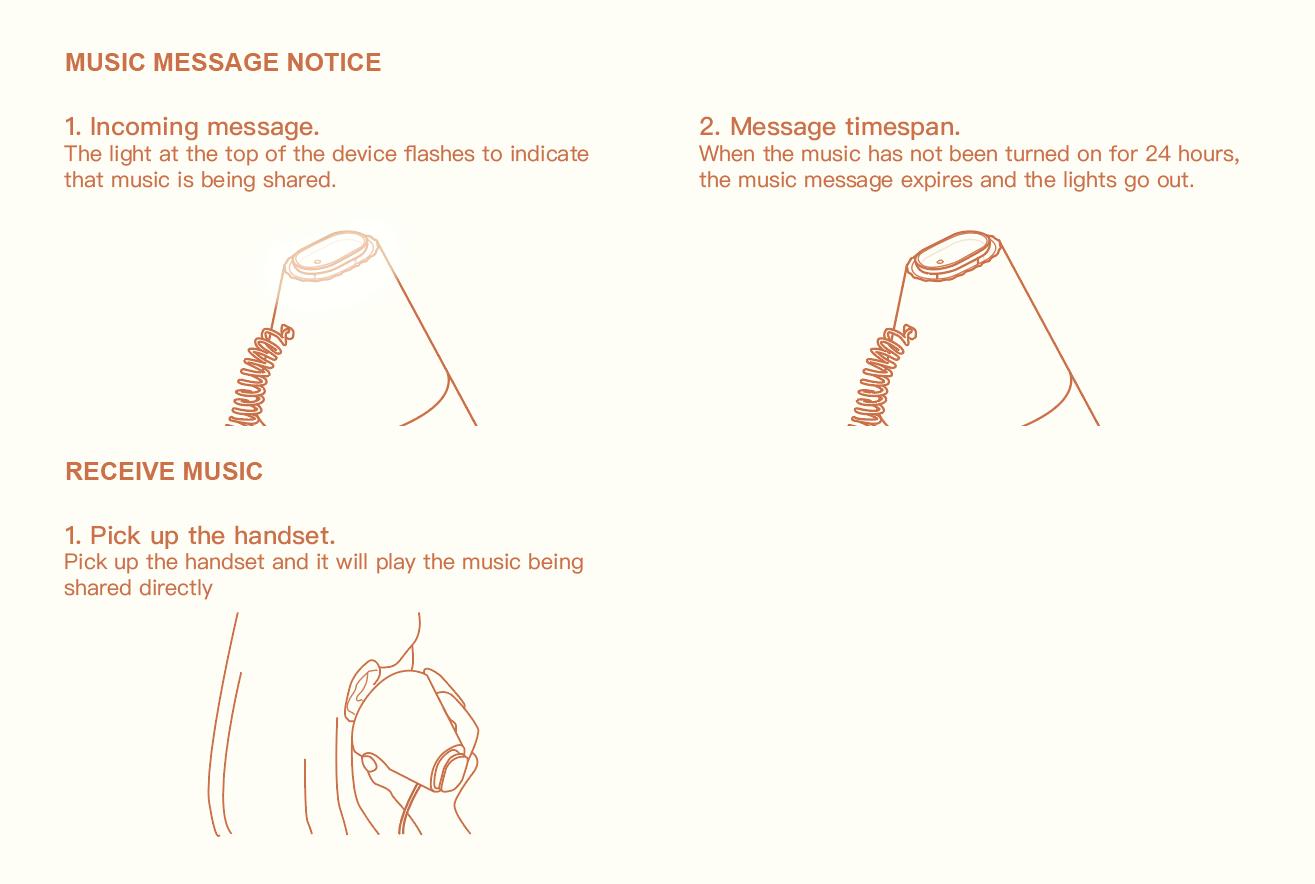
When someone shares music with the user, a flashing light will appear at the top of the product to remind the user that a music message has been delivered. Each music message notice will remain for 24 hours and disappear after that time. This interaction is intended to be a gentle reminder that music has been shared, instead of the conventional cold web link that is used to share music. This light will also be less intrusive when the user is studying or working. When the user lifts the handset, the built-in speaker will start playing the
music being shared, while the name of the person who shared it will appear on the display. Until the music is opened, the user is not informed of the sharer, the name of the music, or the name of the artist. By opening the blind box, the shared music becomes a gift with a sense of surprise, thus encouraging the person to open the music more often.
At the same time, information about the music being shared will also appear in the corresponding music app.
SHARE MUSIC
When the user wants to share music, they lift the top half of the handset, rotate the button along the slide to select the person to share with, and finally press the button to send the message. Once the message has been successfully sent, "sent" will appear
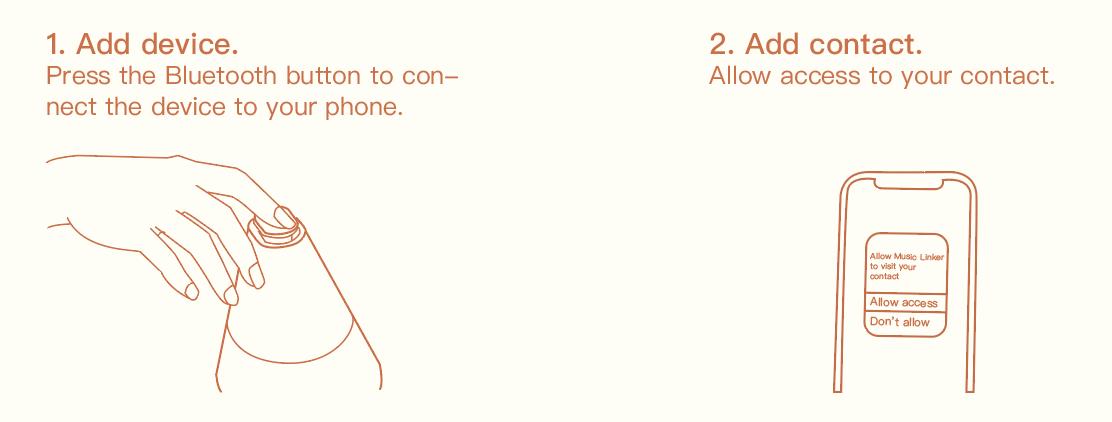
on the screen to confirm that the message has been sent.
The shared music information will also appear in the internal music sharing module of the corresponding music app.
Music Linker -M2.1 design project Music Linker -M2.1 design project 32 33
Fig. 26
Fig. 27
Fig. 28
MUSIC LINKER
FIRST SET UP
Add the device to your App You can self name your device and get relevant information
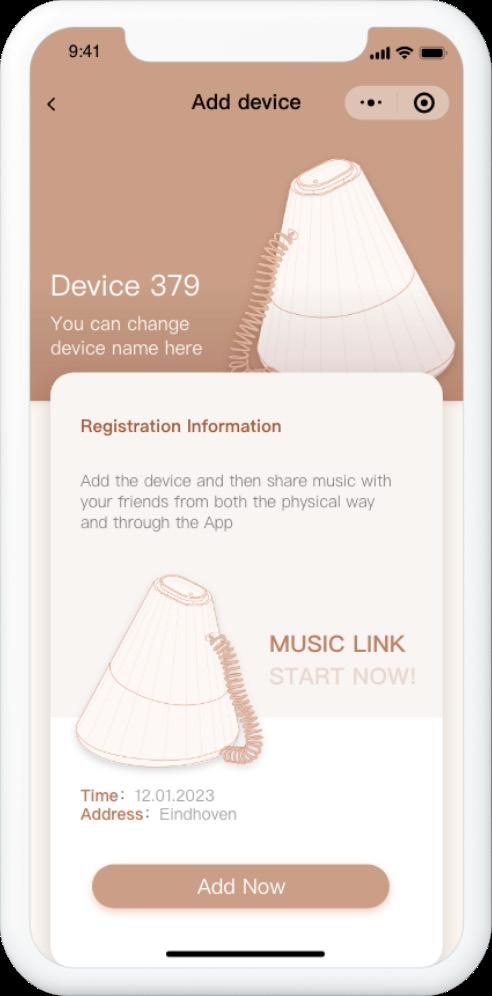
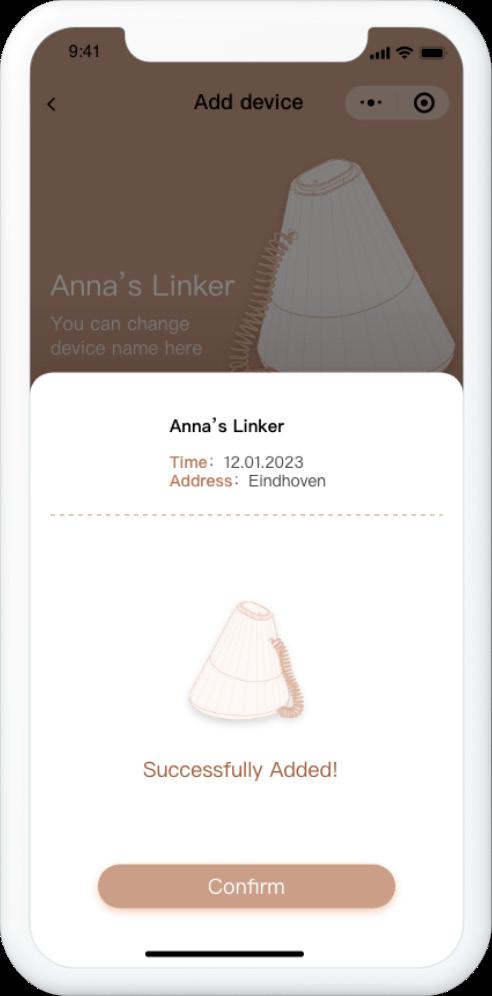

INVITE FRIENDS AND SEND MUSIC MESSAGE
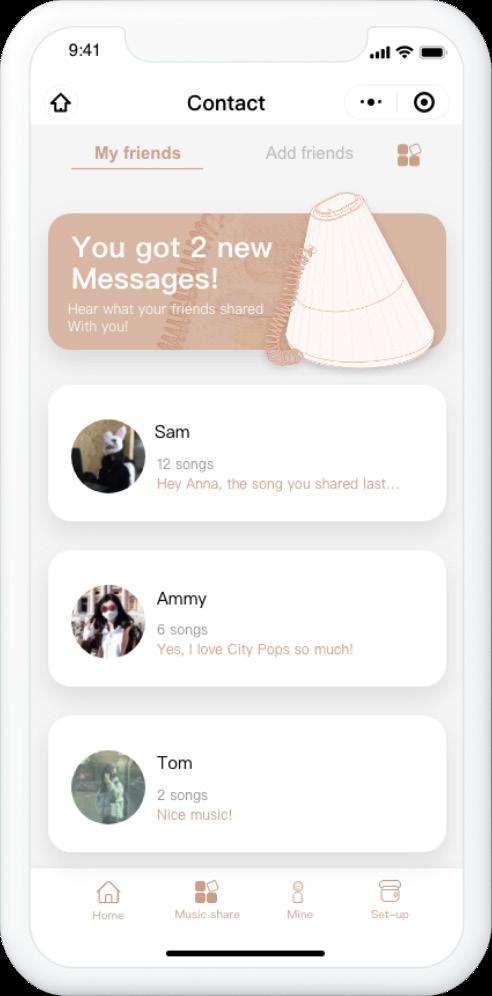
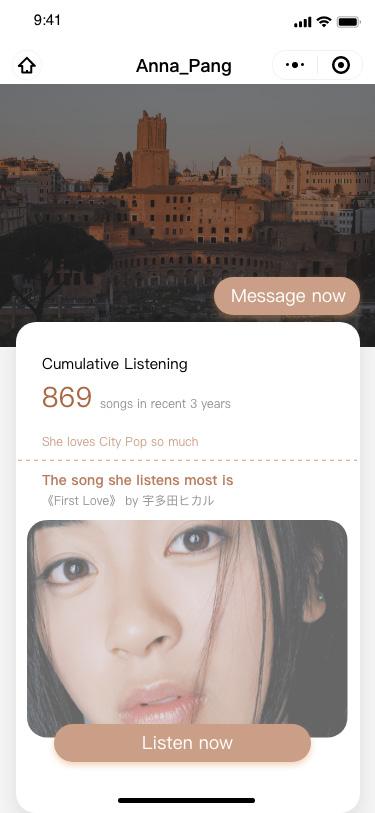
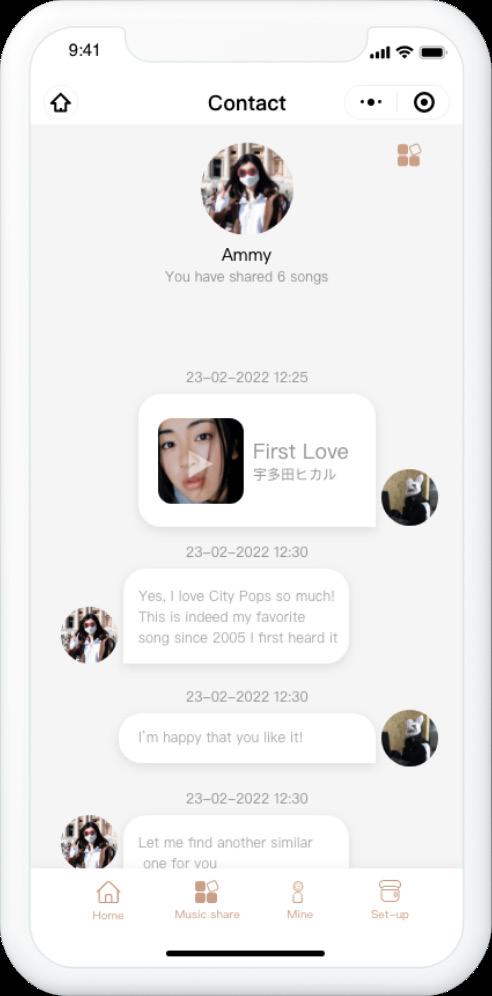
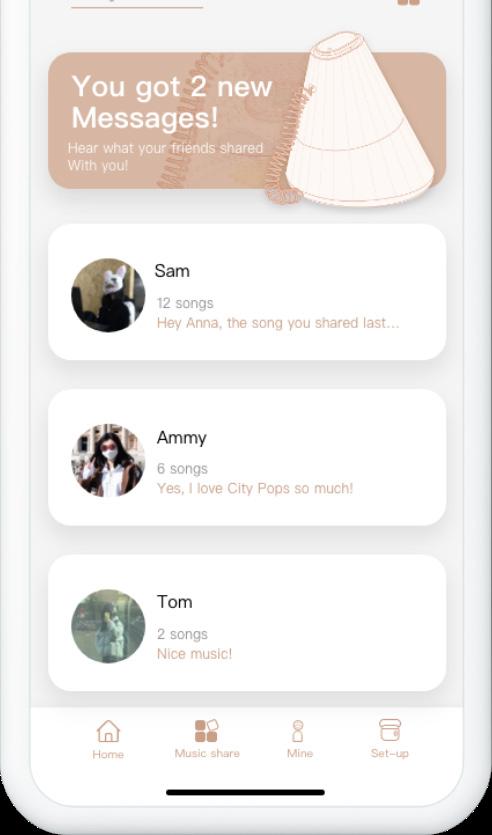

UI DESIGN
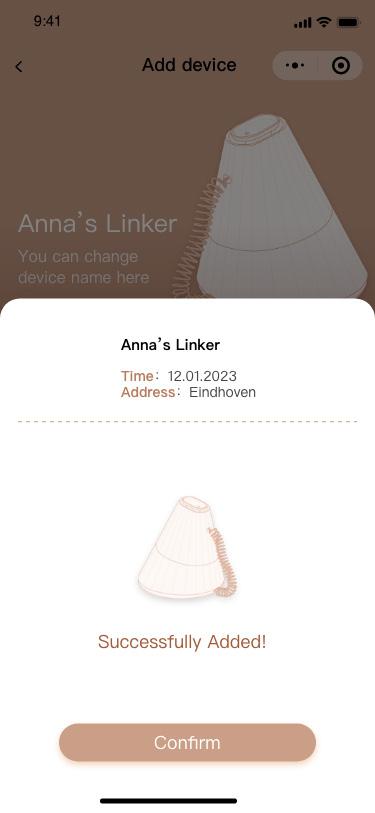
This section shows the design of the interface for the online platform and includes only the interfaces that correspond to the key steps in the physical interaction process. This is to facilitate the reader and

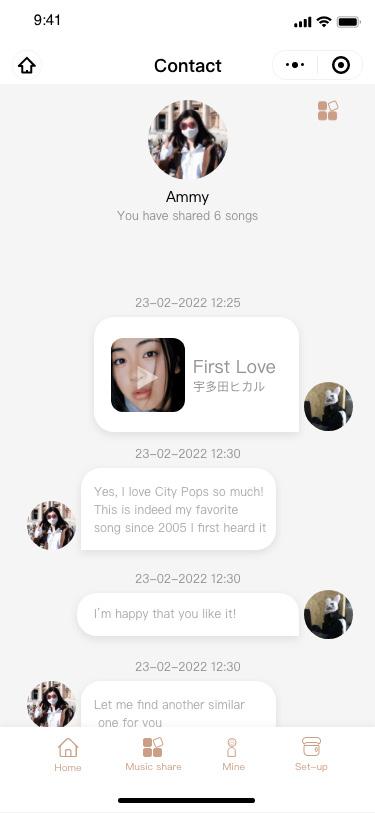
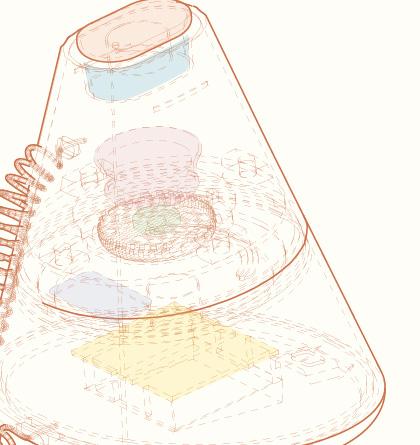
the participants in the user test process in understanding how the physical product corresponds to the streaming platform.
The photo used for 宇多田ヒカル is derived from: https://www.universal-music.co.jp/utada-hikaru/ Instagram Logo is derived from: https://commons.wikimedia.org/wiki/File:Instagram_logo_2016.svg
Music Linker -M2.1 design project 34 35
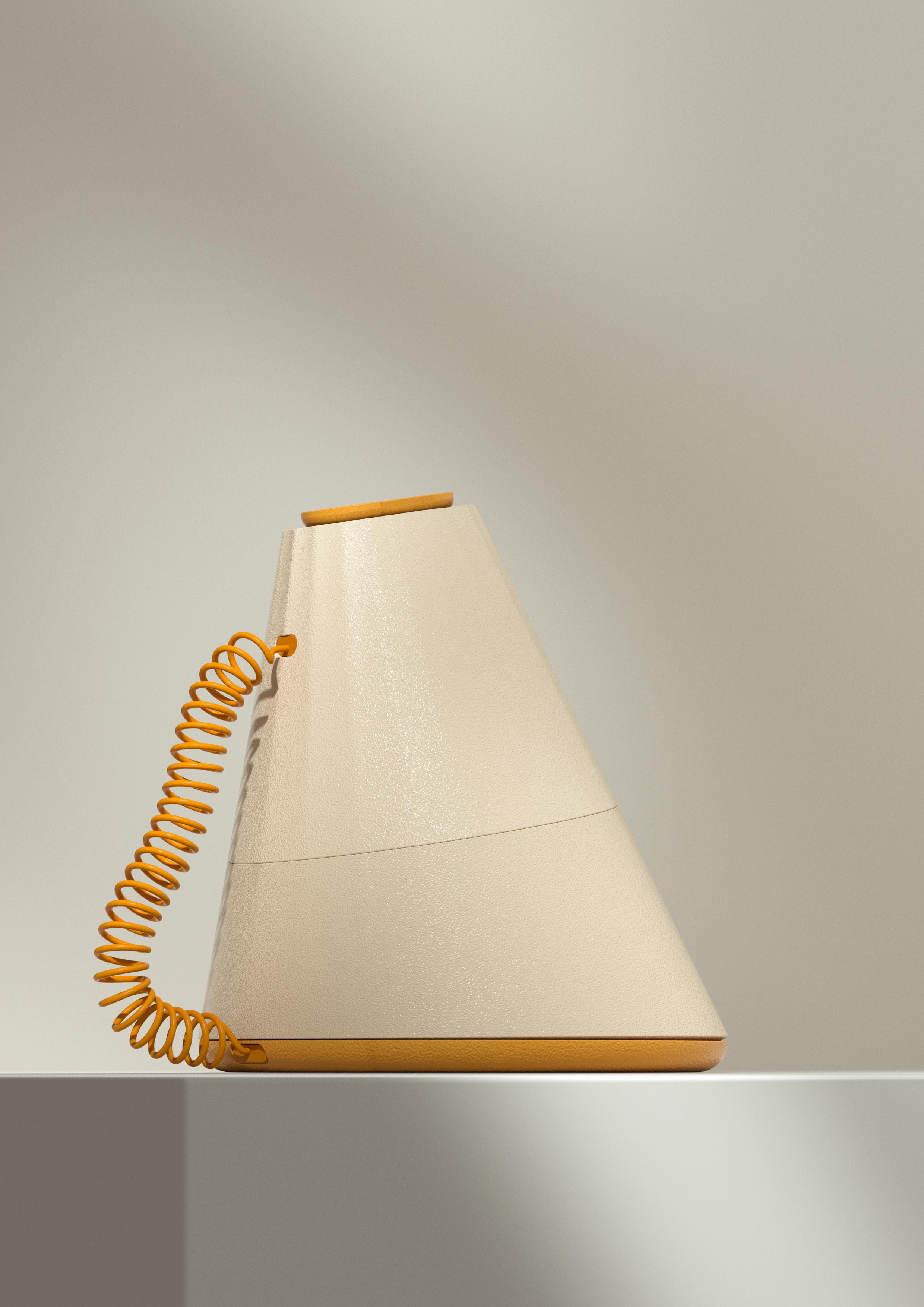



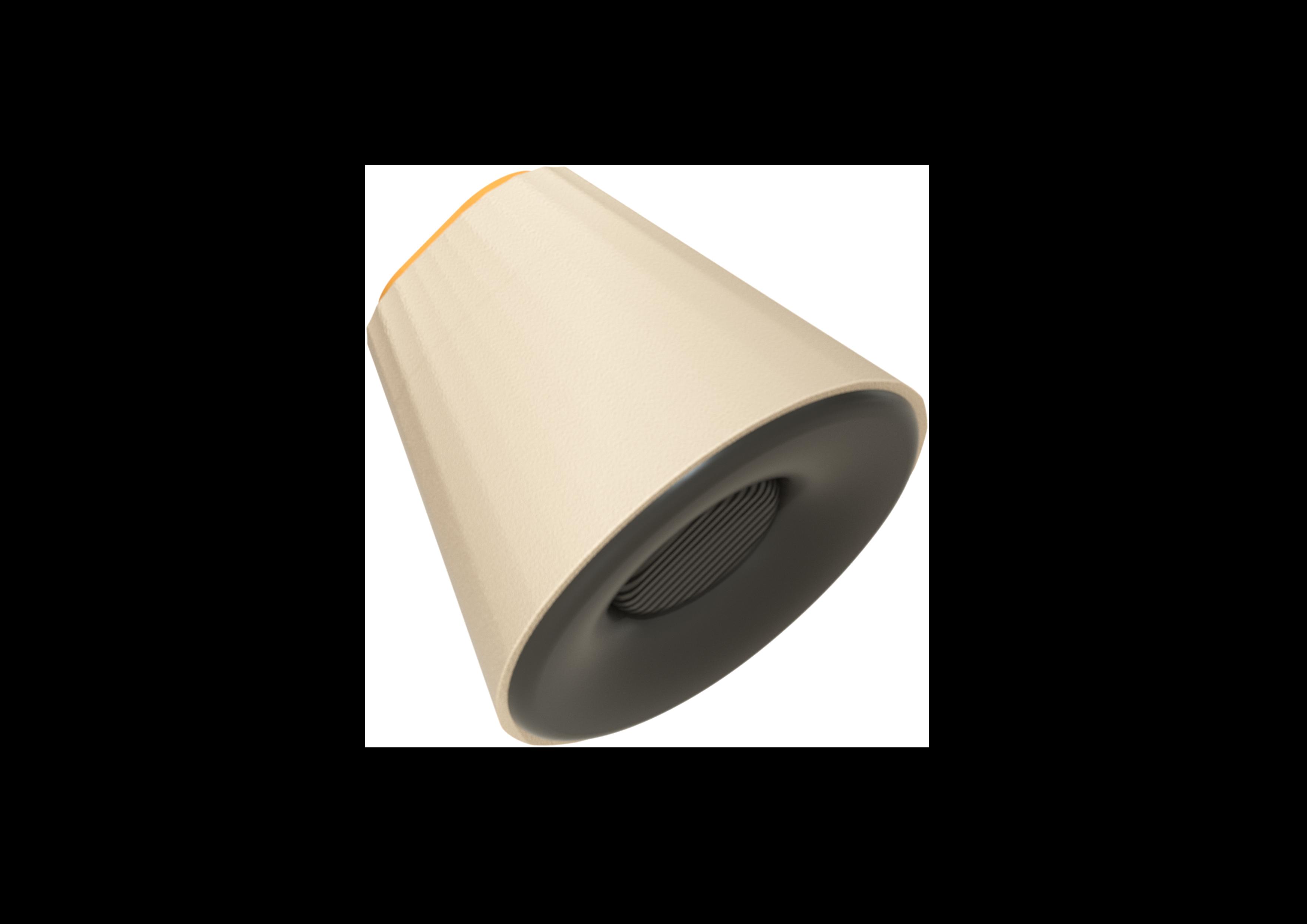
Music Linker -M2.1 design project 37
Fig. 29,30
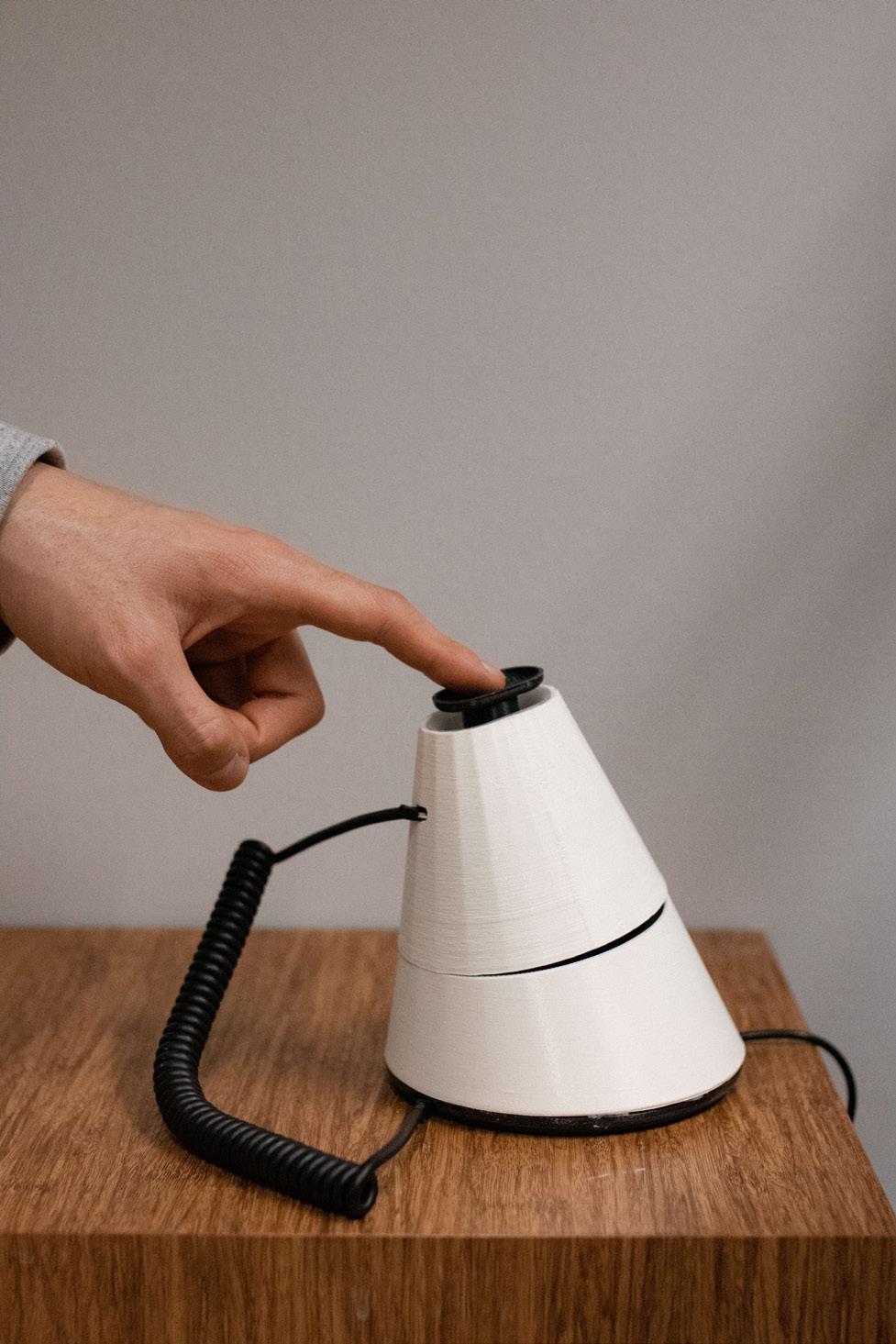
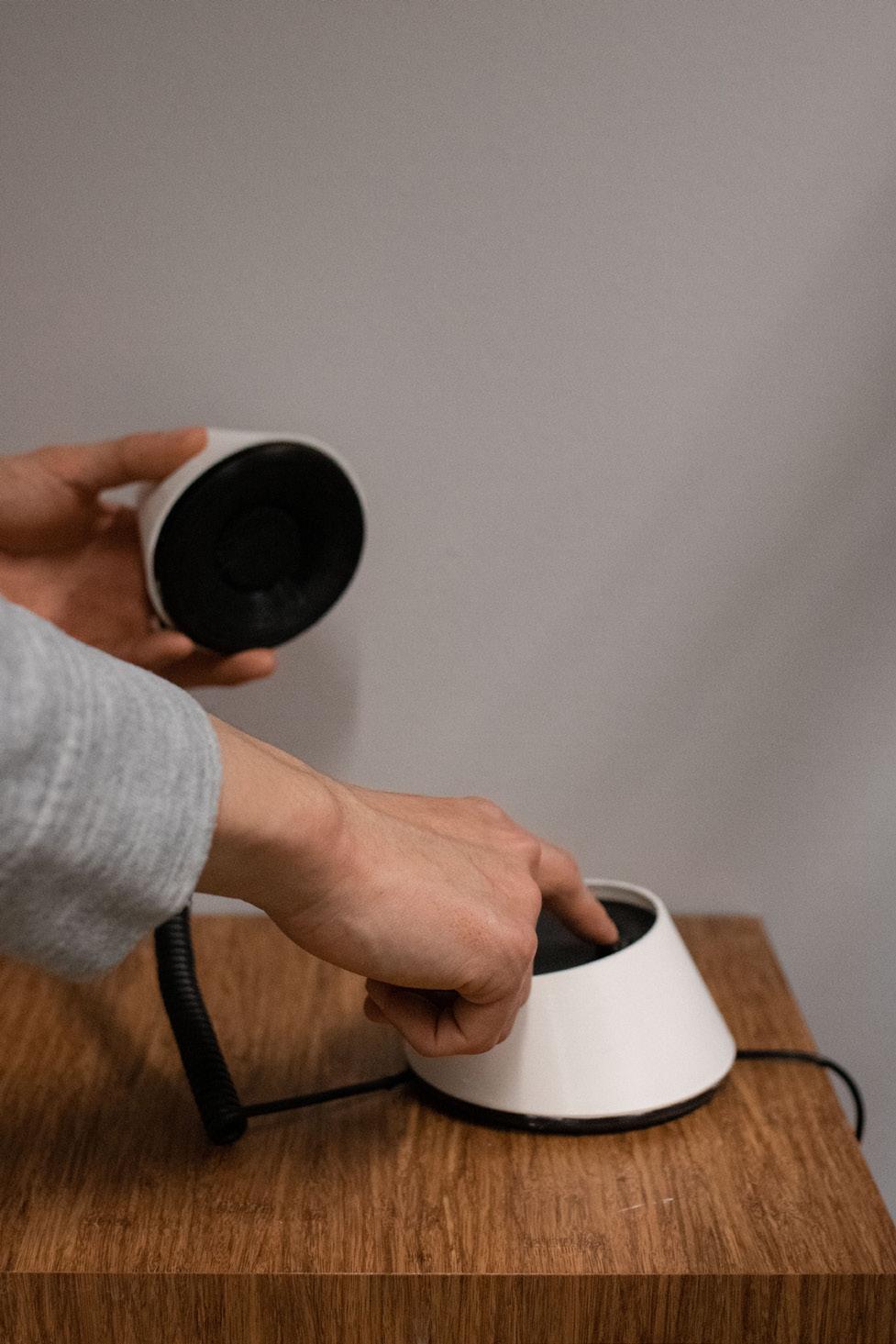
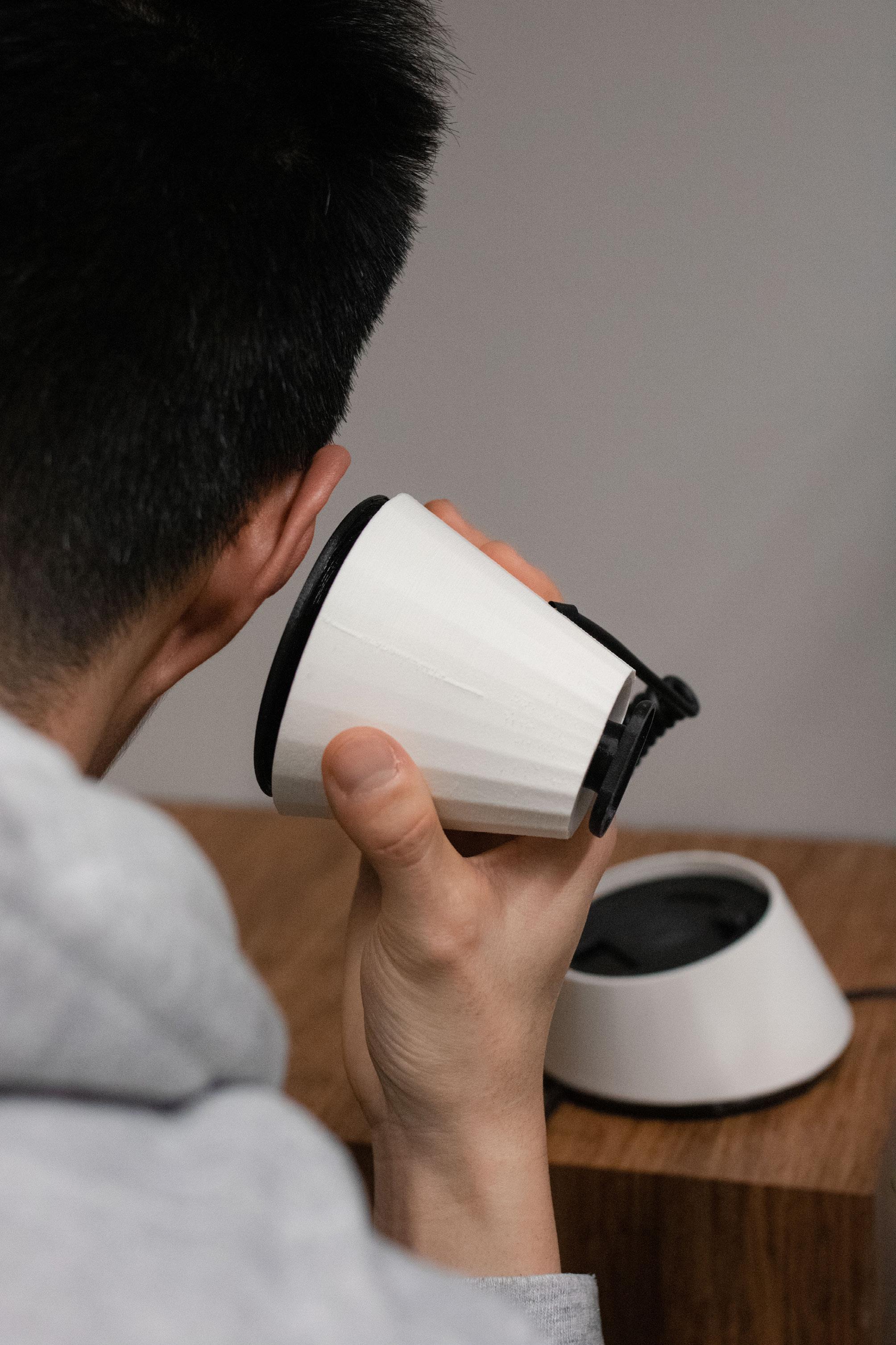
Music Linker -M2.1 design project Music Linker -M2.1 design project 38 39
Fig. 31,32,33
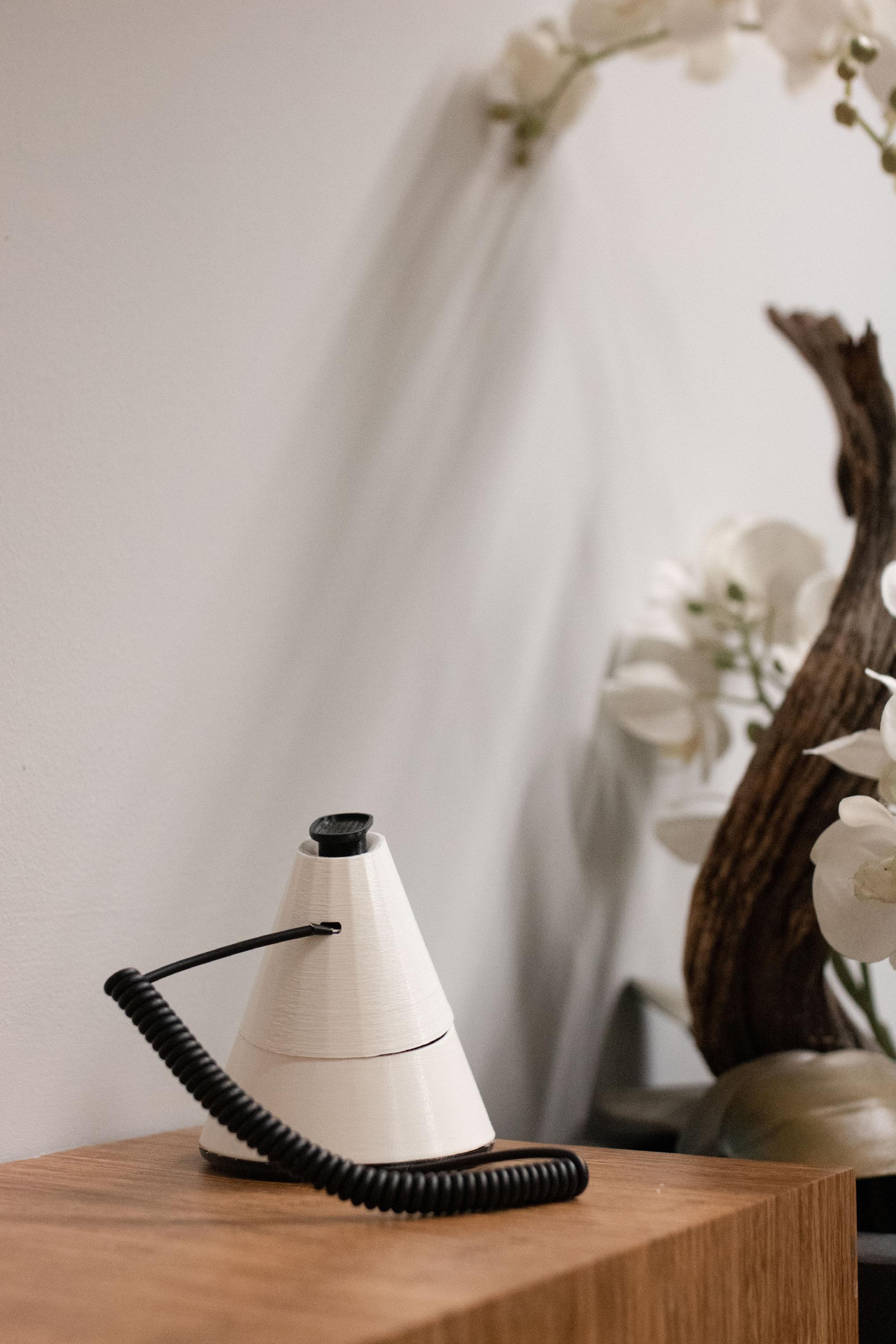
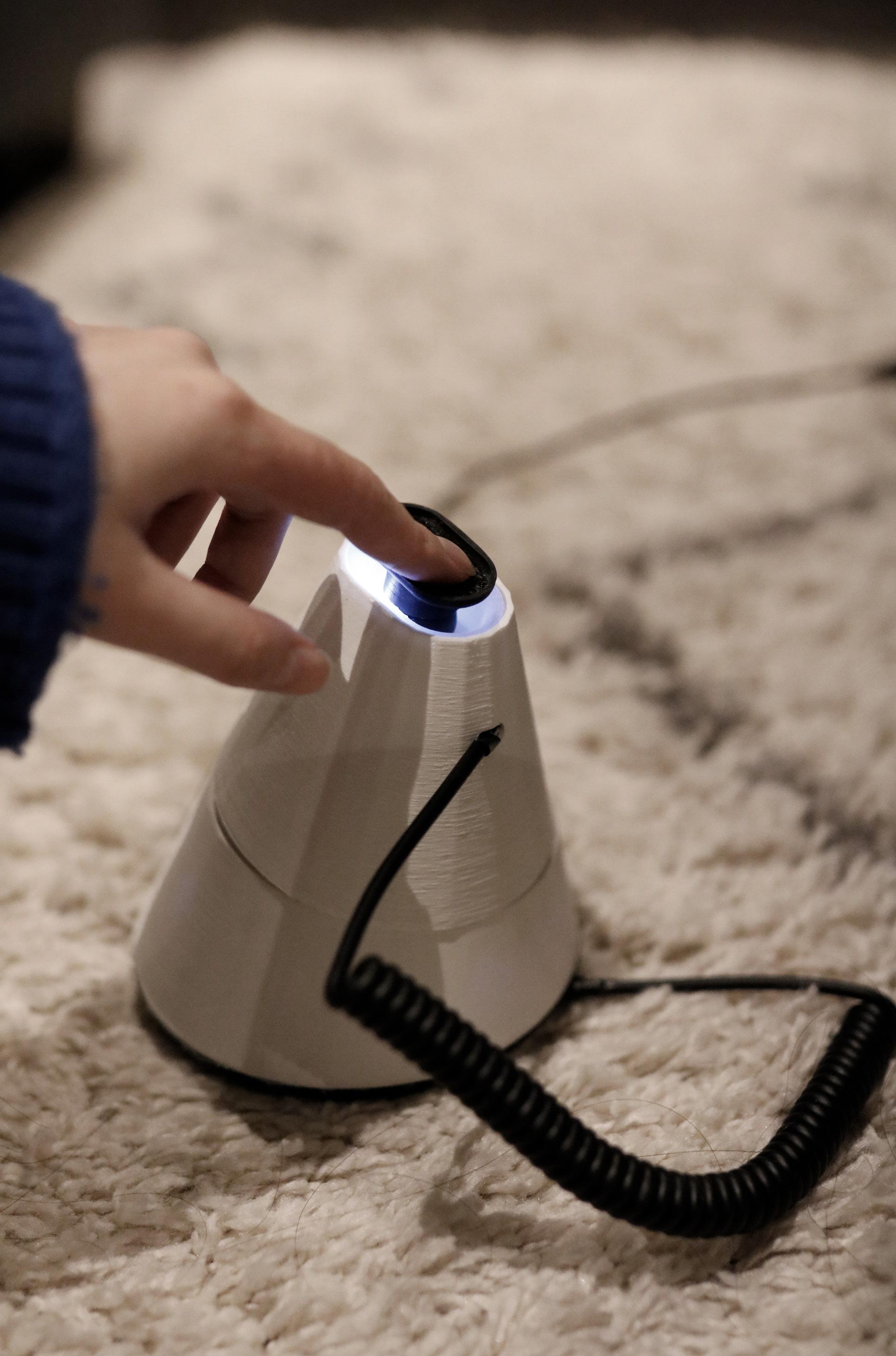
Music Linker -M2.1 design project Music Linker -M2.1 design project 40 41
Fig. 34,35
7.1 METHODOLOGY
Participants
For this user test, I recruited participants by posting about the information on social media, and eight students from different disciplines at Eindhoven University participated. The participants were aged between 22 and 27 years old, of which six were female and two were male. The test was conducted in strict compliance with the Ethical Review Board (ERB) from the Industrial Design department. All participants read and signed the Consent Form with details of the test procedure, data collection, and privacy protection prior to the test. In the subsequent analysis, all the data collected in the experiment were anonymized. The basic information about the participants and their anonymization numbers is shown in Table 2.
using the product for the first time. After an introduction to the product, the participant was asked to complete two simple tasks based on the themes of sharing music and receiving information about music. Each task had a specific scenario and exact instructions. In order to provide the participants with a homelike environment, I invited two of the participants who lived in the same apartment as me to test the product in my home. The remaining six to test it in a laboratory setting that was set up to simulate a living room environment. The two test tasks and the specific instructions can be found in Appendix B.
After the tests were completed, the participants were asked to take a semistructured interview to further demonstrate the user experience with Music Linker. The interview will start with the participant's basic music-related habits and experience of sharing music. Finally, the interview will return to the experience of using the Music Linker itself, asking the participant about the specific shape of the product, how it physically interacts with the lights, the overall interaction process, and what functions they feel are missing or would like to see added during the process.
The whole experiment was divided into three parts: introduction, test, and interview, and took about 30 minutes in total.
At the beginning of the experiment, participants were given a copy of the product instruction booklet to read on their own and were able to ask questions and have them answered by me at any time if they did not understand or were confused. During this process, I noted all the things that they found difficult to understand when
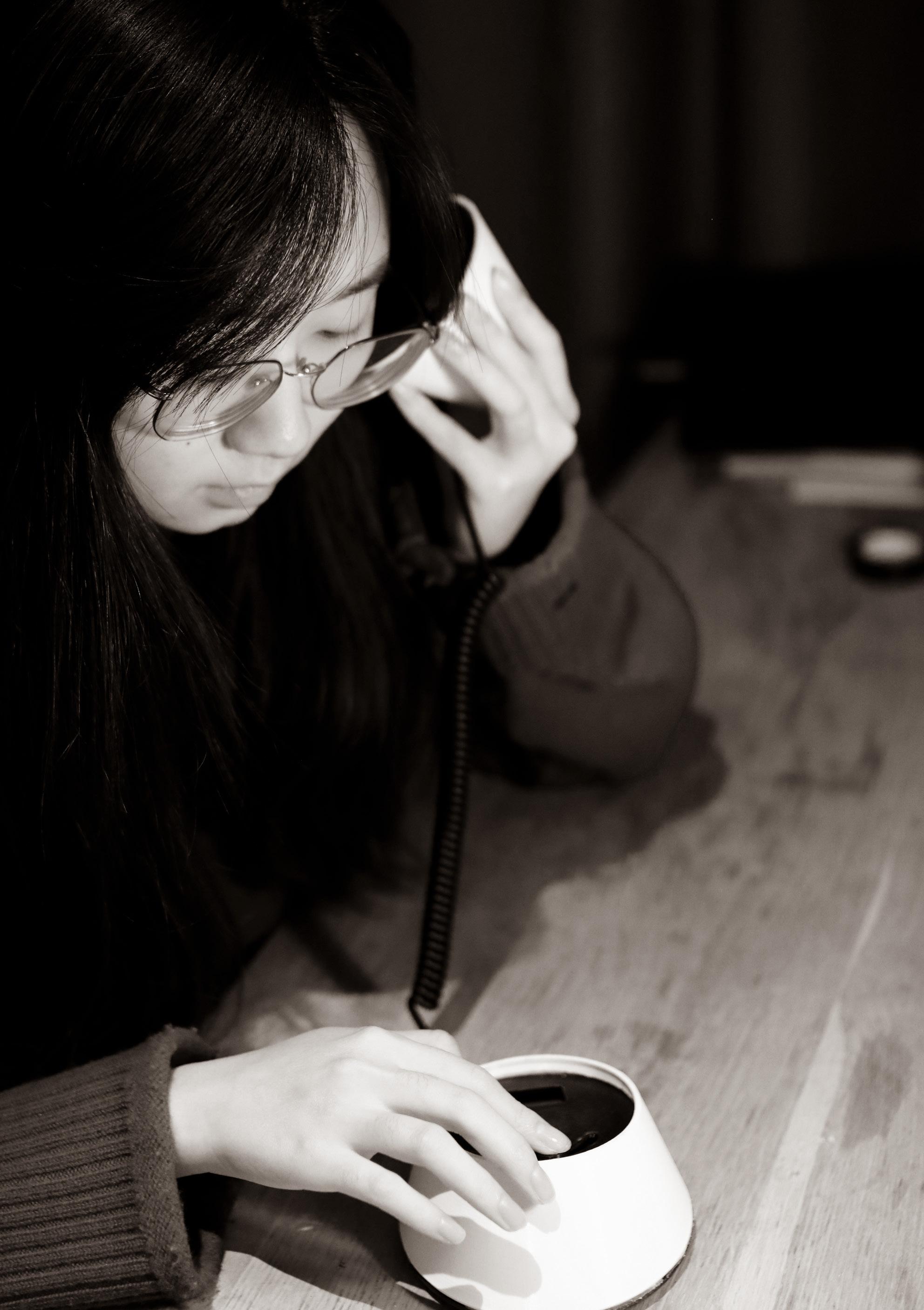
Analysis
For all the audio recordings collected during the interviews, I first transcribed them into Word documents. For all the transcribed textual information, as well as the observations of the user's use of the product during the interviews, I used Thematic Analysis for coding [19]. During the analysis, three broad thematic codes were created: Aesthetics, Experience and Expectation.
Music Linker -M2.1 design project 43 USER TEST & EVALUATION 07
ID Age Gender A1 22 Female A2 24 Female A3 27 Male A4 24 Female A5 25 Female A6 27 Female A7 24 Female A8 24 Male
Set-up
Table 2
7.2 FINDINGS
The participants were generally appreciative of Music Linker as an innovative product for physical music sharing and were willing to explore its usability. However, through the observations of users in actual use and the analysis of interview data in the user tests, Music Linker still has much room to improve.
Aesthetics
In terms of overall appearance, the majority of participants expressed their appreciation of the shape of the product and felt that the simple but design-oriented shape would be a good decoration for their home.
However, some felt that the overall look did not clearly highlight the theme of sharing music. When asked if the shape of the product helped users to associate the product with music sharing, A2 said, "I think the image of the top half of the product is quite consistent, but when it is closed, I can't see the shape inside, so it feels a bit introverted, that is, at first glance, I might
not think that there is a screen and audio inside. " A5 also mentioned in the interview that when the earpiece is on top of the lower part, the features related to the theme of sharing music are not obvious. A6 said that the element of the earpiece is visible when it is open, but "it's slightly less imaginable when it's closed."
There are two other details need to improve to the styling of the Music Linker. Firstly, when reading the instructions, more than one user had questions about the process of selecting the target audience, and they were mainly focused on the step of pressing the button to confirm after rotating it. The main reason for this is that the confirmation function and the rotation of the selected object are performed by the same button, which may cause confusion for the user at the first operation. In addition to this, I observed that during the swiping of the button, the user tends to press the upper surface of the button to swipe. This usage increases the risk of mistouching during the process, which could lead users to press
the button during the swipe to send it to the wrong person to share it with.
Secondly, the Bluetooth connection button on the top of the earpiece is confusing to users. Several users pressed the button first when receiving a music message during the test, even though there are no instructions to do so in the product instruction manual. This might be because the earpiece as a whole is used for music reception, and most users would normally do something to confirm reception before receiving a message.
Experience Interaction
In terms of interaction semantics, participants reported that they felt a sense of connection through music when using the product, which is exactly what the product hopes to offer users in terms of interaction. A3 said, "I think it fits well with the theme of sharing music in my mind; there is an act of listening and then there is a more intuitive act of sharing, and the overall message is clearer."
In terms of ergonomics, it is unfortunate that the design of the earpiece does not provide a good grip for the user. During the test, I observed a number of participants trying to use the model for the first time in slow movements and expressing doubts about how to grip it properly. A3 said, "It's a bit hard to hold, it slips."
compared with normal music share flow
The performance of this physical model in terms of receiving music information is a significant improvement in user usability and experience compared to the traditional music sharing flow. During the experiments, participants stated that the feature of flashing lights to indicate music information was the most significant difference compared to the traditional music sharing flow, and that they all appreciated and liked
this form of interaction to varying degrees. This is because all participants indicated that their usual way of sharing music is by forwarding links to songs on social media platforms, which makes information such as the name of the song and the artist directly visible at first glance, which may have a significant impact on whether the recipient of the shared music is interested in opening it. A3 commented that "before, music was shared by sending a message, and that didn't make me want to click on it. Because I can see directly what the song title is and who the artist is, and if I don't like it, I really won't click on it at all, but with this one, it's just a light, and I'm most curious about what it is, why it's on, who's sending the message to make it light up, and I just want to listen to it and feel like opening a blind box." A2 said, "This model really exceeded my expectations, it's the feedback from the light or whatever it is that really makes me feel like, let's see who's sharing the song with me."
In particular, many participants felt that this type of message cue would encourage them to share the music more often, and A2 thought that "the flashing light would be a very motivating way. I would expect people to share it with me, and then we would share it with each other." Similarly, A3 mentioned that "it makes me more open to others sharing their music."
Also, the light indicator that gently reminds users of the availability of music messages without being intrusive to what they are currently doing, was also mentioned by many participants as a more comfortable experience than traditional forms of music sharing.
As for the process of sharing music, Music Linker received mixed reviews. Most users said that using a physical product to share music adds a lot of ritual. A6 also said, "I feel like usually, if I want to share music, I'm more likely to do it directly with the App. So I think I only prefer the way it receives music."
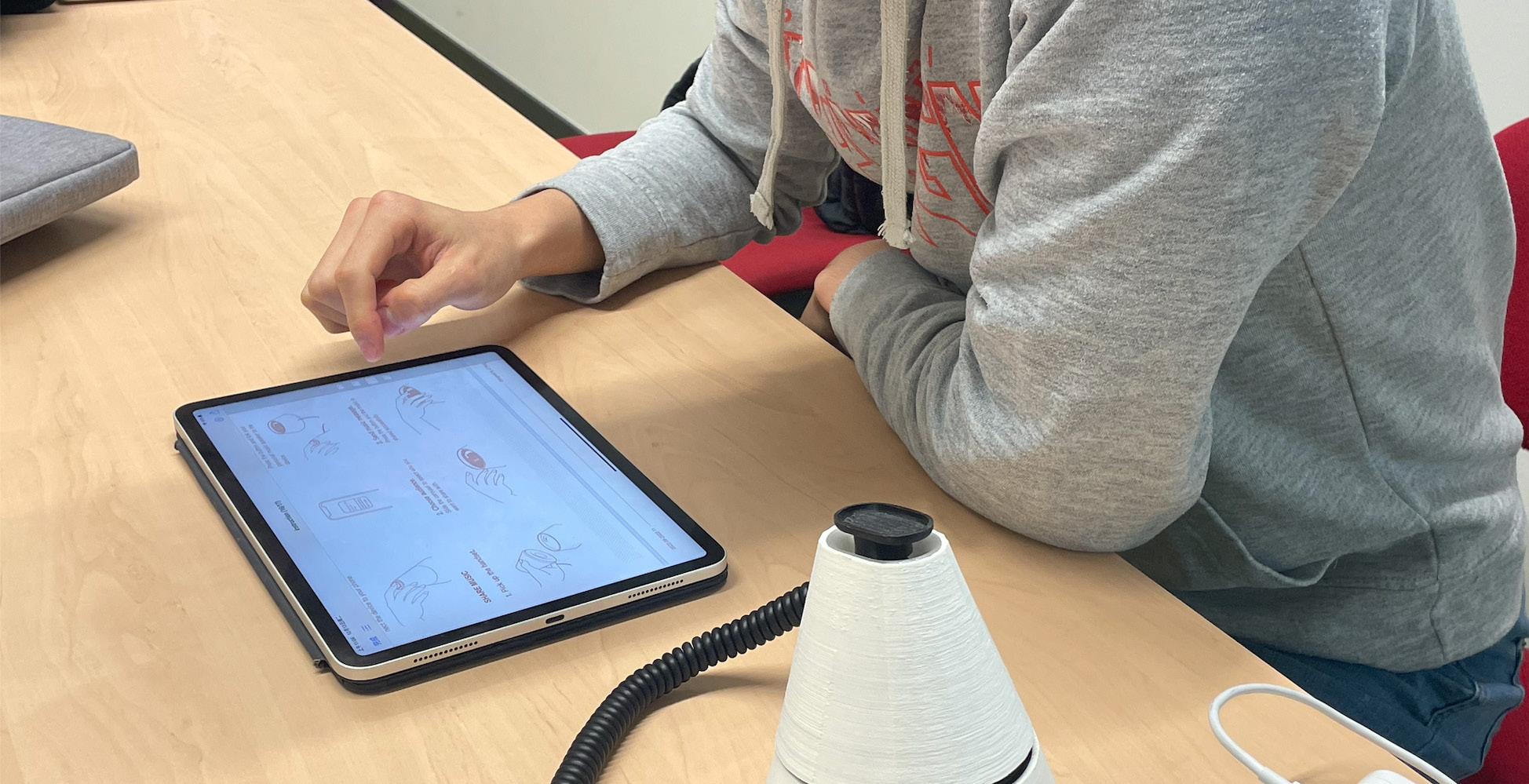
Music Linker -M2.1 design project Music Linker -M2.1 design project 44 45
Expectation
The form of feedback that user desired
When asked about the features they would like to have added, the most frequently mentioned one was that they would like to have simple feedback channels. For example, A5 would like to be able to see if the message was read by the recipient; for her, knowing that they received and opened the message is sufficient feedback. More participants wanted a simple way to tell the person if they liked the music, with A1 saying, "Just to be able to send another message to say if they liked it or not and that sort of thing."
More possibilities for light interaction design
After showing their appreciation for the light cues, two participants suggested that they would like to see more interesting light signals. A6 wanted the interaction of the lights to be customizable to set: "There could be such a thing that would allow the lights to be changed by themselves so that they could be played with friends for a bit."
A8 would like the light to be constantly on, to maintain a regular brightness when there are no music messages, and to flash when there are messages, so as to provide the user with a sense of certainty that the product is ready for use. In addition, he wanted the light to change to respond to the user's actions when sharing music or other
7.3 LIMITATIONS
First if all, there was a disproportionate number of women in the test audience. In the world of product design, it is generally believed that gender differences influence aesthetic choices to a greater or lesser level [27].
Secondly, this trial was limited to observing consumers' initial responses and brief encounters with the product. In fact, it is intended that the product would
interactions were completed, and for the associated app to behave correspondingly.
The need for external playback of the earpiece
A number of participants mentioned that when receiving music messages, they would like the earpiece to be placed on a table or other flat surface for playback. A3 said, "It's not convenient for me to hold and listen to a song if I'm on my phone or using another device at the moment." The average length of a song is 2–3 minutes, and if more songs are shared, the listening time will be longer. The design of the earpiece makes it necessary for users to hold the product in one hand for long periods of time, which can cause fatigue and make it difficult for them to do other things.
The need in different scenarios
A1 suggested that this physical product might not be easy to use in the environment where she usually listens to music, and the same concern was raised in A3's interview. From the interviews about the participants' usual music listening and music sharingrelated behaviour, it was clear that many of the participants listened to music on mobile transport or outdoors, such as at school or work. Therefore, the physical product part of the shared music service is not applicable to this type of outdoor listening scenario.
7.4 DISCUSSION AND FUTURE WORK
The goal of this project is to inspire people to share and converse more about music. Currently, there is a wealth of research on the technical and permissions aspects of music sharing. However, studies on the music sharing experience are few and far between, and are mostly focused on interface design and the distribution of music on online media platforms.
Music Linker, as an innovative attempt at a physical music sharing service, has yielded valuable insights from its design process and user-test phase, contributing to the following three main dimensions:
BE PAID TO THE WAY IN WHICH INFORMATION IS PRESENTED.
keep customers inspired to share music throughout time, whether they do so enthusiastically or by receiving information from others. However, users may only get a fleeting glimpse of the design and usage of this cutting-edge device throughout the 30-minute experimenting phase. Particularly for a product that offers the user a feeling of ritual through physical connection, people's initial enthusiasm for a new product is likely to wane with time.
As can be seen from the findings, the interactive process of receiving music information was generally appreciated and discussed by the participants. It is also the most significant improvement in this physical product compared to the music sharing process in streaming music services. From the pre-project user interviews and research on the current mainstream streaming apps, it is already evident that shared information is more likely to be accepted when it is more visually appealing. For example, among the various ways of sharing music, exchanging vinyl records is more attractive than directly sharing web links. One important reason is that vinyl has a unique design aesthetic and a retro feel. Based on this, Music Linker has created a new way of prompting music sharing information through light interaction, which has proven to be more appealing. It is also a more gentle way of indicating the presence of a light, which helps avoid the inconvenience of sharing music via social media platforms when the recipient is studying or working.
In particular, the appeal of Music Linker to the participants is also due in part to the "blind box" strategy. Unlike the usual situation, where users see the full information from the shared message and decide whether to play it based on their own musical preferences, the majority of users will open the "blind box" without knowing any information about the song. The "blind box" is a way to hide some of the information from the customer, making the experience of purchasing and using the product more exciting and surprising [8]. When this strategy is applied to the dissemination of music sharing information, it can increase the likelihood of successful music sharing by bringing a sense of novelty and surprise to those being shared. This conclusion can be applied not only to Music Linker and more potential physical music sharing products in the future, but also as an inspiration for the development of streaming music applications. When more attention is put into the way shared music is presented to make the music message visually pleasing and appealing, it is more likely to be accepted by those recipients. At the same time, messages should be presented in a way that takes into account the user's musical habits and usage scenarios, which could prevent disturbing the users.
2) THE ADVANTAGES OF COMBINING PHYSICAL INTERACTION WITH STREAMING FEATURES.
From the overall user test results, it is clear that the physical interaction is more appealing to users than simply sharing music from an online link. Firstly, the physical product itself has a stronger visual impact and appeal to the user through its styling and volume than the intangible streaming software. Secondly,
Music Linker -M2.1 design project Music Linker -M2.1 design project 46 47
1) IN THE DIGITAL MEDIA ERA, ATTENTION SHOULD
the styling of the Music Linker's earpiece echoes its interactive meaning, i.e., it extracts the interactive style of the paper cup earpiece and echoes its appearance. The combination of styling and interaction makes the product a more immersive experience for the user. Finally, the haptic interaction with the physical product enhances the sense of connection that the participants feel when they use the product, enabling them to feel more of an emotional connection to each other through sharing music.
However, Music Linker also shows us that streaming platforms also have advantages that are difficult to achieve with physical interaction. It allows users to access a huge online library of music more easily and to meet more of their needs in outdoor scenarios and other usage situations.
With the development of the digital revolution, dematerialization has become an irreversible trend. It makes information more flexible and free-flowing and actively encourages the blending of cultures from all over the world. In this process, however, many valuable and irreplaceable features of the physical objects are also being lost. Dematerialization and the material world need to coexist in harmony, through which we could provide users with a better user experience [26].
3) THE APPROPRIATE FEEDBACK MECHANISMS CAN FACILITATE THE FORMATION OF POSITIVE COMMUNICATION LOOPS.
Previous user study in the report has implied that the gap between actual and desired feedback received by users was a significant disincentive to share. By leaving the feedback function blank, Music Linker was able to capture user-initiated needs and expectations for the feedback mechanism.
depth of feedback they expect is maintained at a similar level. Firstly, it is certain that the majority of sharers require feedback from the sharee to verify that the message was effectively transmitted. Secondly, a higher proportion of users felt that a simple indication from the recipient as to whether they liked the music was sufficient motivation for more sharing behaviours. Deeper communication in the context of music can involve musical preferences, individual identities, and connected experiences. When Music Linker adds more and more social features based on the inherent social nature of music, it is likely to overburden the user with social features and undermine its core musical attributes. This is evidenced by the oversocialization of NetEase Cloud Music discussed in the previous part of the report.
Therefore, future social music products should focus on establishing a proper feedback mechanism, finding a balance between music and social, and providing users with truly simple and effective feedback.
08
CONCLUSION

Although the expected feedback varies from person to person, for most users, the
The goal of the project was to improve music sharing and communication experience among digital music users. I conducted the literature review, user study, and benchmark in the early phases of the project, which allowed me to investigate in depth the experience of sharing music and the need and value of the social aspect of music for streaming users living in a dematerialized era. These insights were used in the brainstorming session to inspire the design and manufacture of the Music Linker, a physical innovation.
As a physical design to help people share and receive music information, Music Linker's interactive form and shape incorporate a number of thematically relevant vintage physical product features. It provides a richer and more interesting user
experience, inspiring people to share music more often.
During the final user test, the highly-detailed model helped me gain a great deal of insight into how the physical product itself and the physical interactions associated with the theme enhanced the user experience. However, it also revealed a number of missing design details.
Most importantly, through user testing, I discovered additional design insights that could aid in optimizing the music sharing experience, both for potential physical products in the future and for streaming music applications.
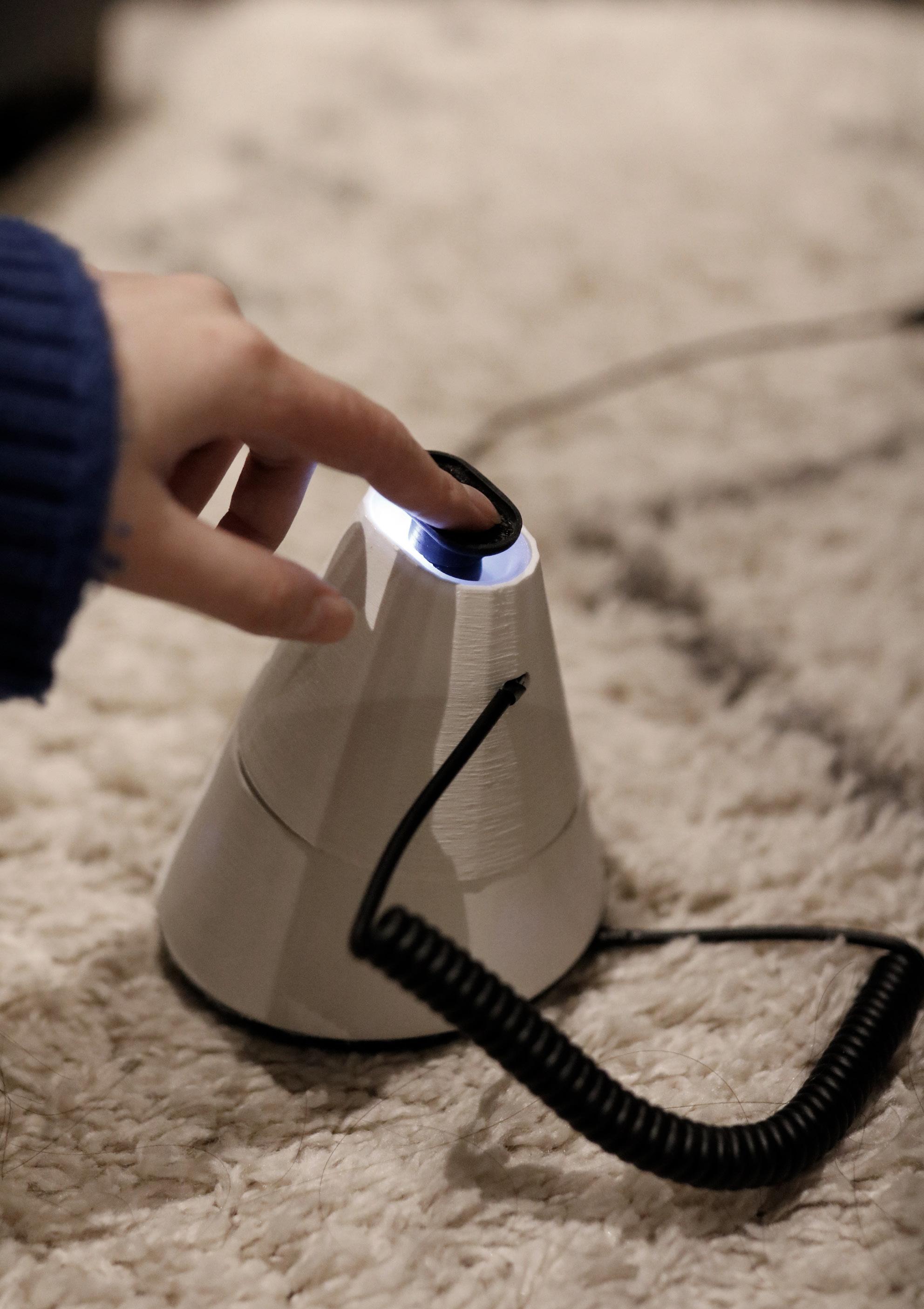
Music Linker -M2.1 design project 48
REFERENCE
[1] Diana Boer. 2009. Music Makes the People Come Together: Social Functions of Music Listening for Young People Across Cultures. (2009). Retrieved December 21, 2022 from http://researcharchive.vuw.ac.nz/ handle/10063/1155
[2] Diana Boer, Ronald Fischer, Micha Strack, Michael H. Bond, Eva Lo, and Jason Lam. 2011. How Shared Preferences in Music Create Bonds Between People: Values as the Missing Link. Pers Soc Psychol Bull 37, 9 (September 2011), 1159–1171. DOI:https://doi. org/10.1177/0146167211407521
[3] Jack Clopeck. 2017. Music Consumption: Millennials and Gen Z Disrupt the Industry. Fluent, Inc. Retrieved December 27, 2022 from https://www.fluentco.com/blog/ disrupting-music-consumption/
[4] Niels Chr. Hansen, John Melvin G. Treider, Dana Swarbrick, Joshua S. Bamford, Johanna Wilson, and Jonna Katariina Vuoskoski. 2021. A CrowdSourced Database of Coronamusic: Documenting Online Making and Sharing of Music During the COVID-19 Pandemic. Frontiers in Psychology 12, (2021). Retrieved December 21, 2022 from https:// www.frontiersin.org/articles/10.3389/ fpsyg.2021.684083
[5] Max Hilsdorf. 2020. How social features on music streaming services can finally succeed. Medium. Retrieved December 26, 2022 from https://uxdesign.cc/howcommunity-features-on-music-streamingservices-can-finally-succeed-66a4c2fcd0c2
[6] Morris B. Holbrook and Elizabeth C. Hirschman. 1982. The Experiential Aspects of Consumption: Consumer Fantasies, Feelings, and Fun. Journal of Consumer Research 9, 2 (1982), 132–140. Retrieved December 27, 2022 from https://www.jstor. org/stable/2489122
[7] Paolo Magaudda. 2011. When Materiality
‘Bites Back’: Digital Music Consumption Practices in the Age of Dematerialization. Journal of Consumer Culture - J CONSUM CULT 11, (March 2011), 15–36. DOI:https:// doi.org/10.1177/1469540510390499
[8] Gustave Florentin Nkoulou Mvondo, Fengjie Jing, and Khalid Hussain. 2023. What’s in the box? Investigating the benefits and risks of the blind box selling strategy. Journal of Retailing and Consumer Services 71, (March 2023), 103189. DOI:https://doi. org/10.1016/j.jretconser.2022.103189
[9] Nora Nägele, Benjamin von Walter, Philipp Scharfenberger, and Daniel Wentzel. 2020. “Touching” services: tangible objects create an emotional connection to services even before their first use. Bus Res 13, 2 (July 2020), 741–766. DOI:https://doi. org/10.1007/s40685-020-00114-0
[10] Lauri Nummenmaa, Vesa Putkinen, and Mikko Sams. 2021. Social pleasures of music. Current Opinion in Behavioral Sciences 39, (June 2021), 196–202. DOI:https://doi.org/10.1016/ j.cobeha.2021.03.026
[11] piano. 2022. Music Streaming Statistics in 2023 (US & Global Data). Musical Pursuits. Retrieved January 2, 2023 from https://musicalpursuits.com/musicstreaming/
[12] Jörgen Skågeby and Jörgen Skågeby.
1AD. Online Ethnographic Methods: Towards a Qualitative Understanding of Virtual Community Practices. https:// services.igi-global.com/resolvedoi/resolve. aspx?doi=10.4018/978-1-60960-040-2.
ch025. Retrieved December 27, 2022 from https://www.igi-global.com/gateway/chapter/ www.igi-global.com/gateway/chapter/50355
[13] Rob Strati. 2018. Empathy in user research: setting aside your own point of view. Medium. Retrieved December 24, 2022 from https://uxdesign.cc/empathy-inuser-research-setting-aside-your-point-of-
view-fea438051b0e
[14] Maria Ek Styvén. 2010. The need to touch: Exploring the link between music involvement and tangibility preference. Journal of Business Research 63, 9 (September 2010), 1088–1094. DOI:https:// doi.org/10.1016/j.jbusres.2008.11.010
[15] Naomi Ziv and Revital HollanderShabtai. 2022. Music and COVID-19: Changes in uses and emotional reaction to music under stay-at-home restrictions. Psychology of Music 50, 2 (March 2022), 475–491. DOI:https://doi. org/10.1177/03057356211003326
[16] Qin Yali. 2021. Research on Socialization of Mobile Music Platforms. Master. Chengdu University of Technology. DOI:https://doi.org/10.26986/d.cnki. gcdlc.2021.000736
[17] 2011. Personas: The Foundation of a Great User Experience. UX Magazine. Retrieved December 27, 2022 from https://uxmag.com/articles/personas-thefoundation-of-a-great-user-experience
[18] 2022. 7 Spotify Statistics that can help your business [2022]. Rock Content. Retrieved December 26, 2022 from https:// rockcontent.com/blog/spotify-statistics/
[19] 2022. Thematic analysis. Wikipedia. Retrieved December 28, 2022 from https://en.wikipedia. org/w/index.php?title=Thematic_ analysis&oldid=1127802005
[20] China: market size of online music social and entertainment 2025. Statista. Retrieved December 22, 2022 from https:// www.statista.com/statistics/1291057/chinamarket-size-of-online-music-social-andentertainment/
[21] The Evolution of Analogue and Digital Music. International Business. Retrieved January 11, 2023 from https://bbs.binus. ac.id/international-business/2020/06/theevolution-of-analogue-and-digital-music/
[22] Why is vinyl making a comeback?
- Reader’s Digest. Retrieved December 25, 2022 from https://www.readersdigest. co.uk/culture/music/why-is-vinyl-making-acomeback
[23] Evoking meaning: From tangible objects to digital experience - ProQuest. Retrieved December 25, 2022 from https:// www.proquest.com/openview/ee908c 5d499a8e3fecd40e7c6188c9f8/1?pqorigsite=gscholar&cbl=18750
[24] NetEase Cloud Music: The Undying Social Dream|Songlist_ NetEase Subscription Retrieved January 2, 2023 from https://www.163.com/dy/article/ HBUL1VLN0517CTDU.html
[25] ScholarWorks: MuScale: Designing for Tangible Interaction with Weight in Digital Music Experience. Retrieved January 5, 2023 from https://scholarworks.unist.ac.kr/ handle/201301/31790
[26] Physical Interaction in a Dematerialized World. International Journal of Dsign. Retrieved January 6, 2023 from http://www. ijdesign.org/index.php/IJDesign/article/ view/1124
[27] Gender Differences in Preference for Product Design - Term Paper. Retrieved December 28, 2022 from https://www. termpaperwarehouse.com/essay-on/ Gender-Differences-in-Preference-forProduct-Design/111733
Music Linker -M2.1 design project Music Linker -M2.1 design project 50 51
APPENDIX A FINAL REFLECTION
I want to be a professional product designer, so before I started this semester I had a predetermined goal for my graduation project: it would be an integrated project that would reflect my professional competencies as a product designer, with the final design output expected to be a mature and commercially viable product. As an RDD track student, I plan to focus on design and research development in the M2.1 project, with a focus on Creativity & Aesthetics and User & Society. And in the FMP project I will continue with the same design theme, still with a focus on Creativity & Aesthetics, but I will also focus more on Business & Entrepreneurship to further explore how the design insights gained in M2.1 can be applied to the market. Now, looking back at the end of the semester, I believe that the M2.1 project has largely achieved its initial objectives and in some areas has even gone beyond plan.
Creativity & Aesthetics: Looking back at the development of the whole project, this is the area where I have made the most progress and am most proud of. In past projects, I was used to designing following a linear process: sketching from research, creating a Low-Fi prototype, and then producing the final proposal. However, during this semester's concurrent internship at Philips, I found that my colleagues did not follow this linear process and were more used to iterating and even going backwards to previous steps to help improve the design quality of the product in detail. I therefore tried to apply this approach to the design phase of the styling and physical interaction for my M2.1 project. I did a lot of sketching by brainstorming, then made a number of Low-Fi prototypes for simple testing by using cardboard and 3D printing techniques,
then improved the sketches based on the results, and after setting the general appearance, I made three-view drawings of the product in Illustrator for refinement, then repeated the Low-Fi prototypes and sketches. This iterative design process took almost two months and resulted in Music Linker, which was well received in terms of styling and interactive features during the final user test and demo days. I think the greatest strength of this approach is that it inspired me to constantly reflect and adjust. Although each step may result in minor design changes, the whole product will eventually be perfected through the overlay of details. However, due to time limitations, I was not able to refine and design the materials. In the FMP project, I will allocate time to the design of the colours and materials. Although the physical product will be redesigned in the FMP project, it will still have the same physical interaction features as the M2.1 product, so the new physical product will still have parts that need to be held by the user. The next iteration will need to be made of better materials that are comfortable and easy to grip when the user touches the product.
User & Society : In general, I have continued to use interviews, quantitative research, and Thematic Analysis method for user study this time. But during the first round of user interviews, I gathered a lot of insights about music sharing behaviour, and I hope to be able to better analyze existing interaction processes and design new ones in terms of user behaviour, processes, and perceptions. I therefore reviewed a number of case studies on interaction design and learned about a method called Empathy Map (described in the thesis). Through this method, I categorized all the information
collected from the interviews into five areas - Say, Do, Think, Feel, Hear. The biggest insight for me is that designers should be more observant rather than questioning during the user research phase. In using the Empathy Map, I have found that there are often discrepancies between what users say and what they actually do, and that exploring the causes of these discrepancies can be very revealing for design purposes.
Professional Identity & Vison

From a PI perspective, the biggest contribution of the M2.1 project for me has been to help me find a clearer identity for my professional identity, which is focused on the creative and stylistic design of products. In the past, I defined myself as a designer for the entire product design process, but during this semester's creative and styling iterations for Music Linker, the new design approach allowed me to find myself enjoying the process for the first time, and to discover my strengths in styling skills during the hand-drawn iterations. Although I define myself as a designer specializing in Creativity & Aesthetics, when I design for companies as a professional product designer in the future, commercial and marketing considerations are inevitable. In my final project, I hope to explore the results and design implications of M2.1 from a commercial perspective. I will demonstrate my growth and competence in Business & Entrepreneurship by conceptualizing a music sharing service for a specific streaming service platform.From Vision's perspective, I saw the advantages of combining physical interaction features with streaming services in this project and began to reflect on this. Because I used to be
overly attached to specific forms of design, I was paranoid that the electronic revolution had taken away too much from the richness of the material world and therefore advocated a more physical and interactive approach to design. But I neglected the advantages of dematerialization and the need for it to exist, for example, to help information flow more freely. But this project made me realize that, as a designer, it is important to think first about how to solve problems and what design solutions can accommodate multiple stakeholders, and that the specific form of design should be determined from there.
Music Linker -M2.1 design project Music Linker -M2.1 design project 52 53
APPENDIX B -Mood board
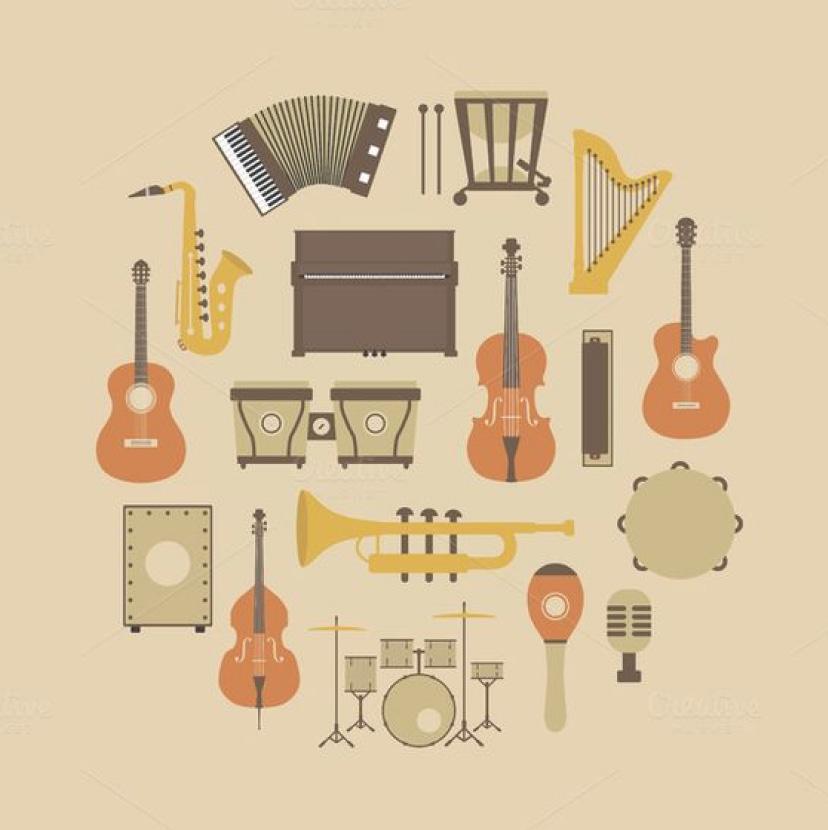
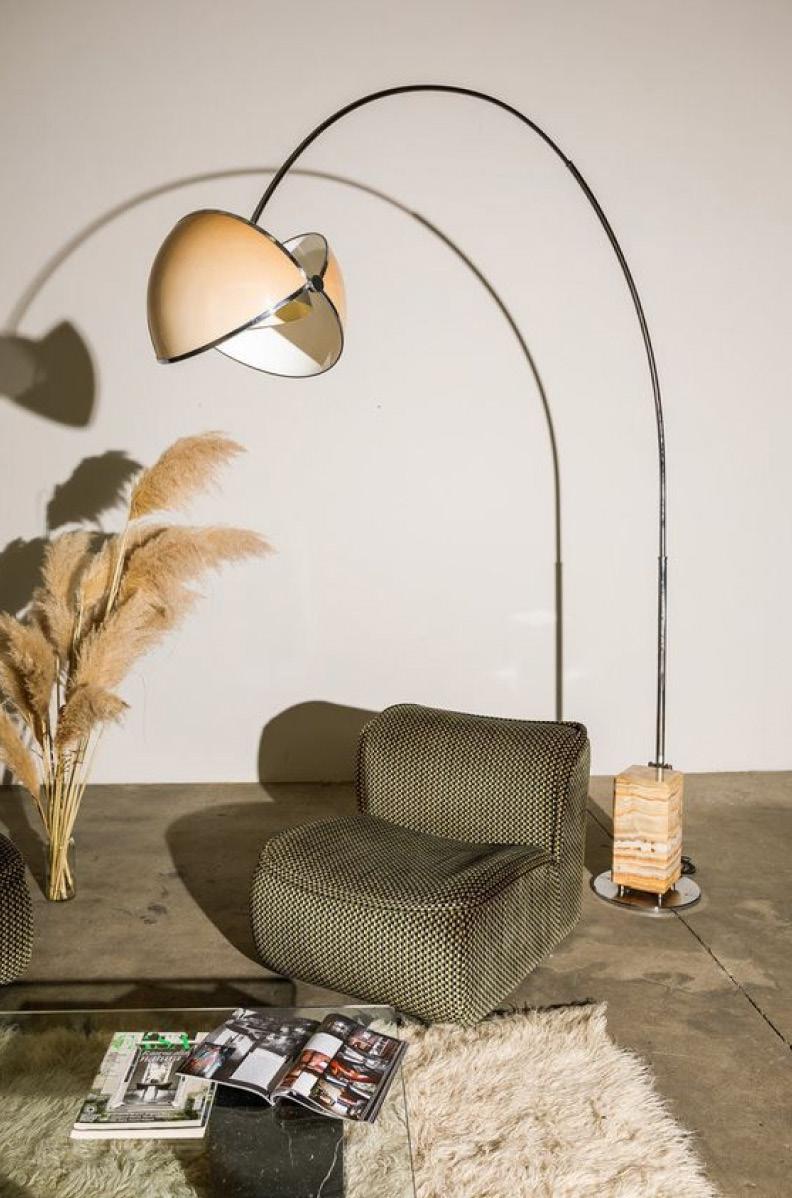
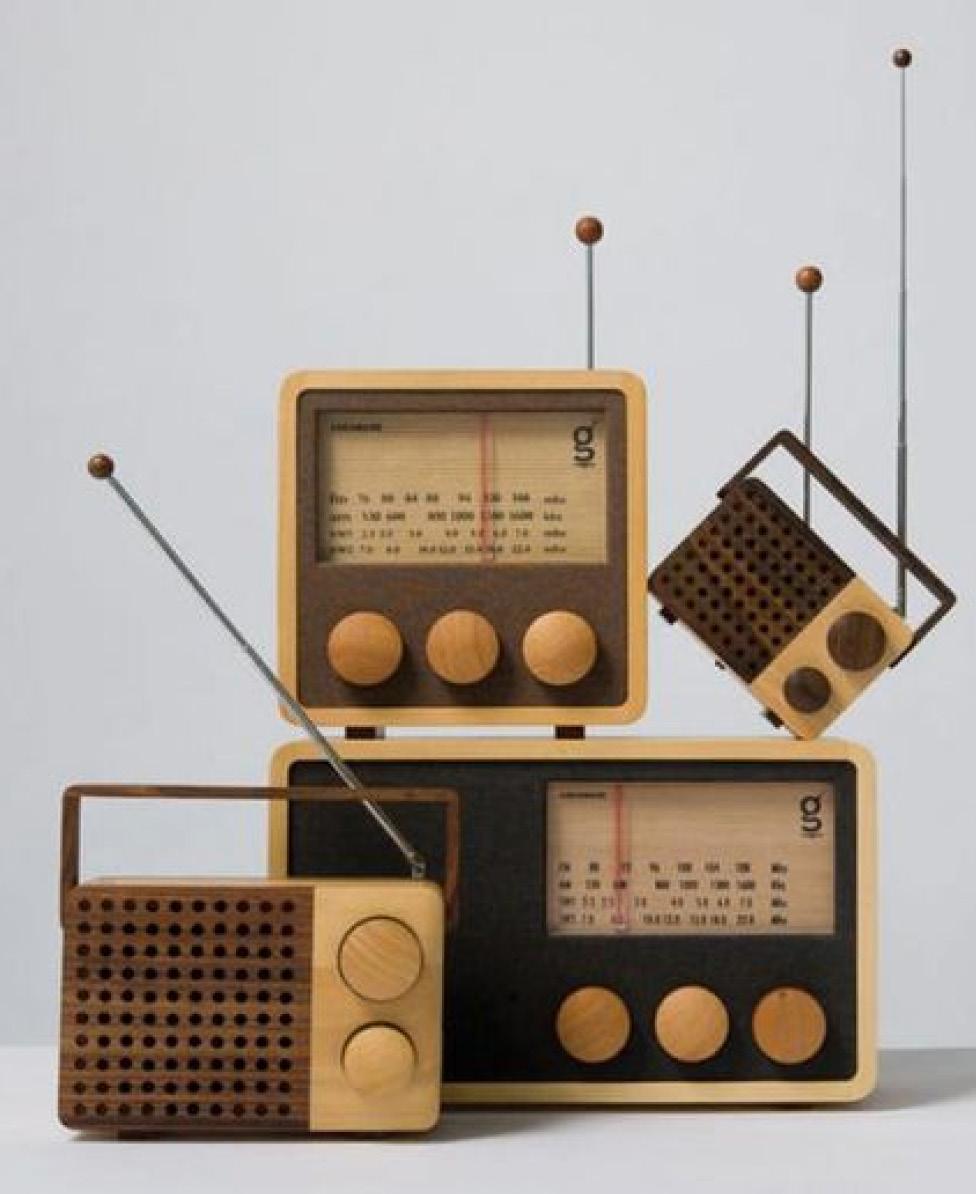
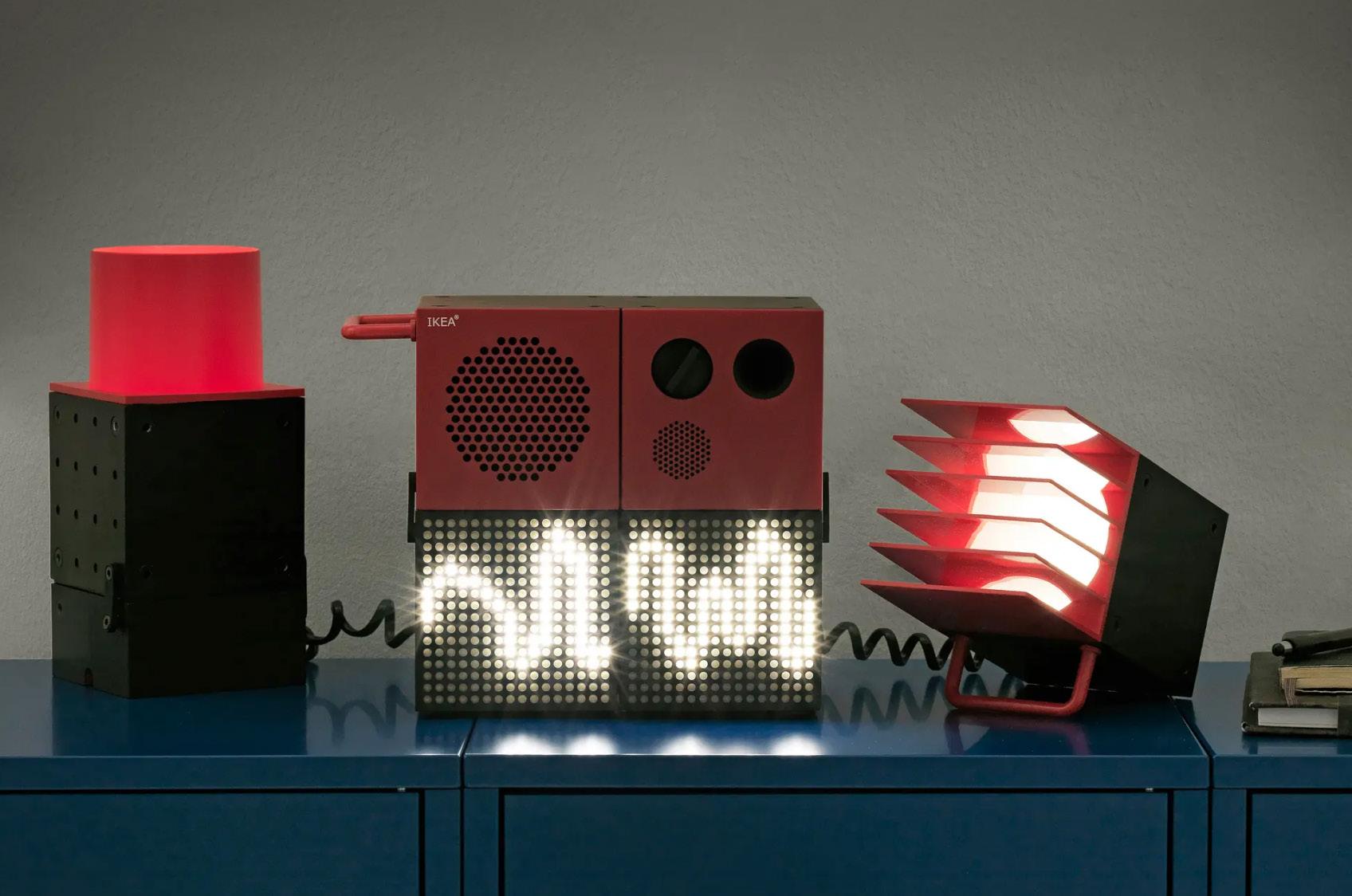

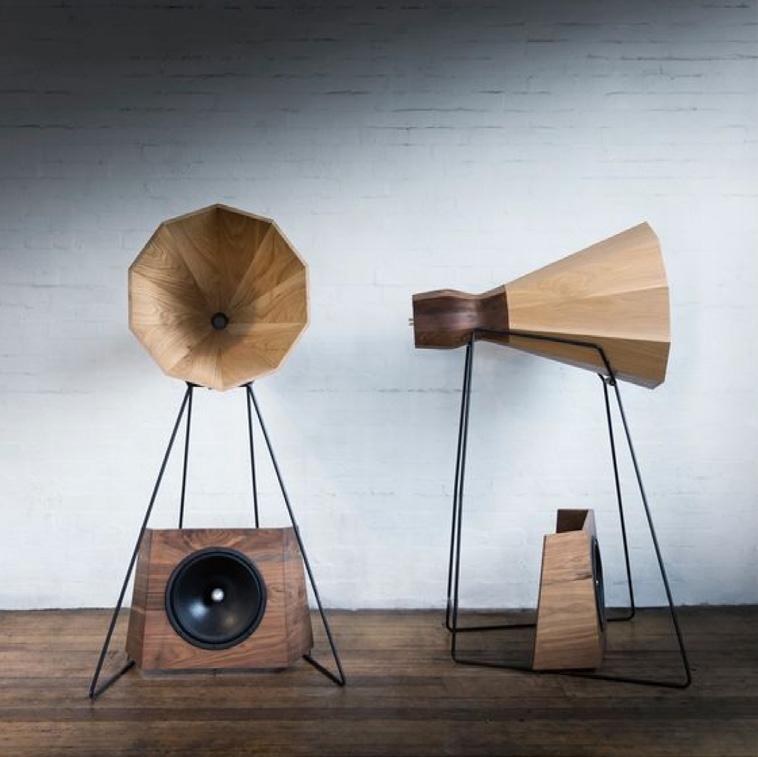
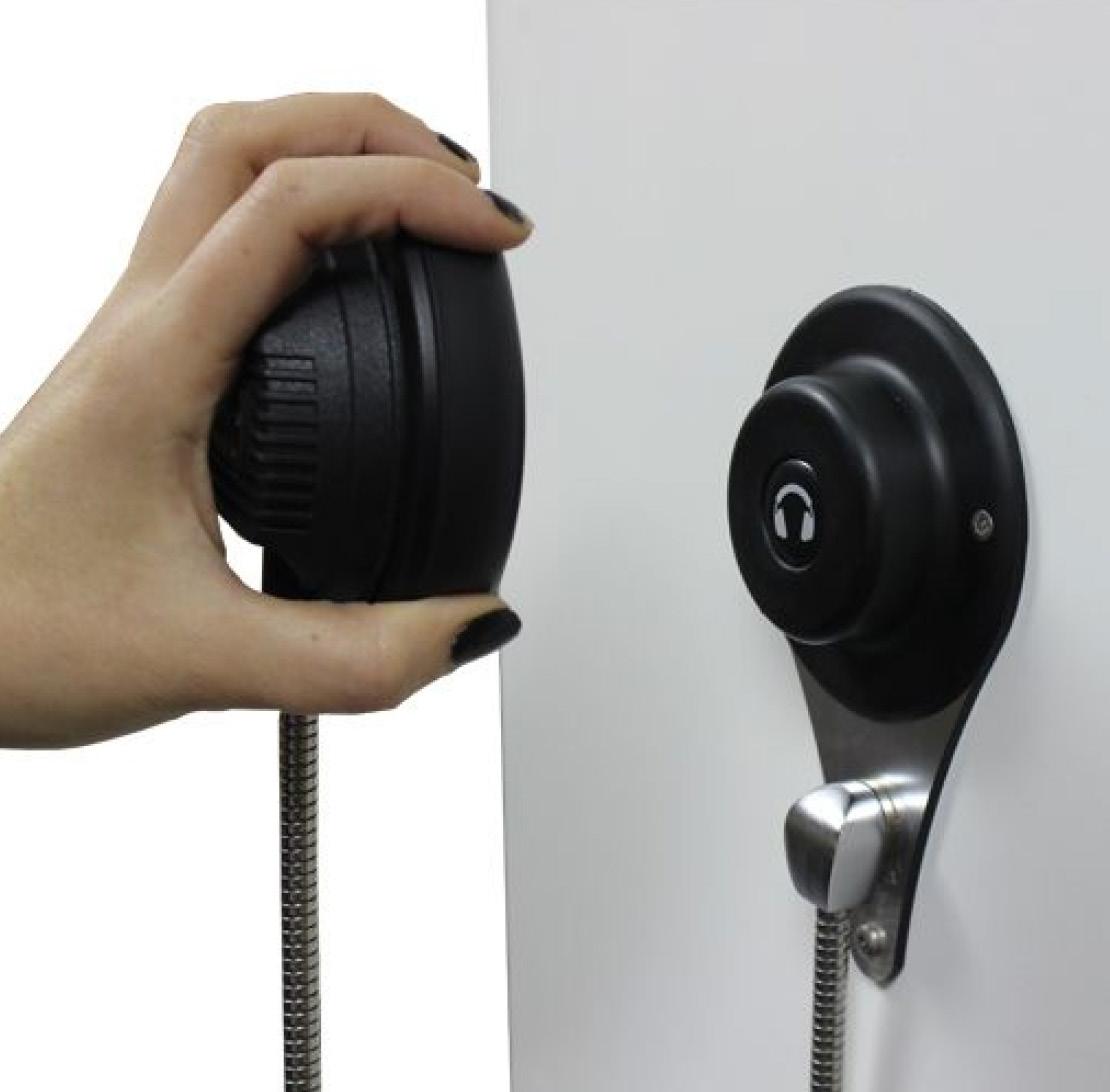
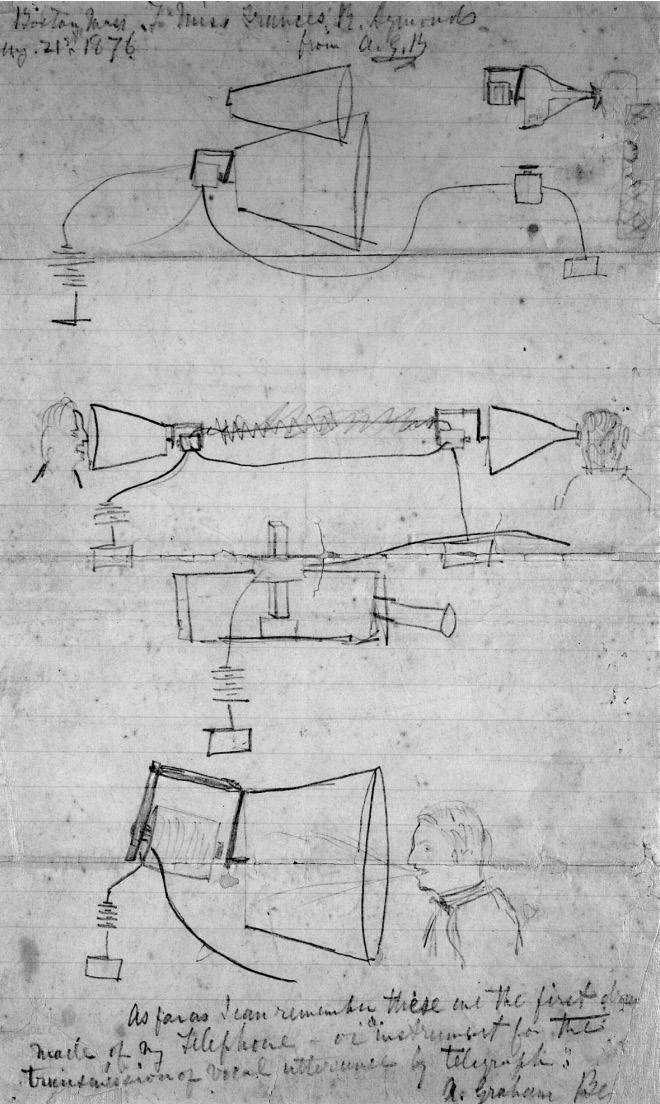
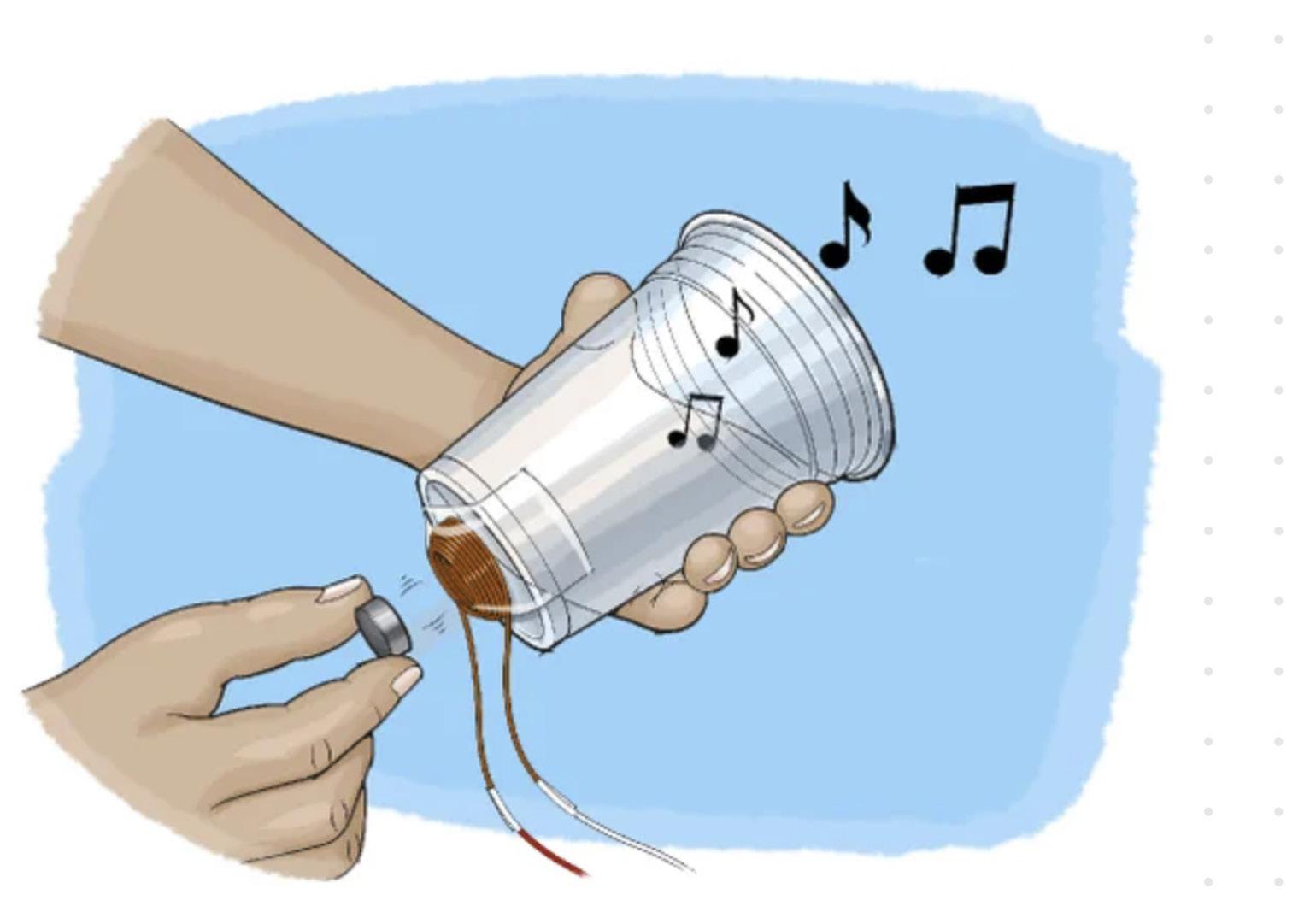
Music Linker -M2.1 design project Music Linker -M2.1 design project 54 55
Fig. 36 (https://www.searchsystem.co/post/190269951733/ teenage-engineering-te-ikea-frekvens-light)
Fig. 37 (https://www.loc.gov/item/ magbell.27300105/)
Fig. 39 (https://www.digitalaudiotechnologies. com/product-category/headphones-handsets/)
Fig. 40 (https://www.scientificamerican.com/ article/build-your-own-speaker/)
Fig. 41 (https://alexearl.com.au/ product/sound-test/)
Fig. 37 (https://www.loc.gov/item/ magbell.27300105/)
Fig. 38 (https://www.castorina.com.au/product/lighting/ display/204-oolok-molok-arco-lamp-by-superstudio,1968-italy)
Fig. 42 (https://www.photophoto.cn/ pic/22708666.html/)
Fig. 43 (https://www.celside-magazine.com/fr-fr/ ikea-frekvens-gamme-enceintes-bluetooth/)
APPENDIX C -User Test Materials
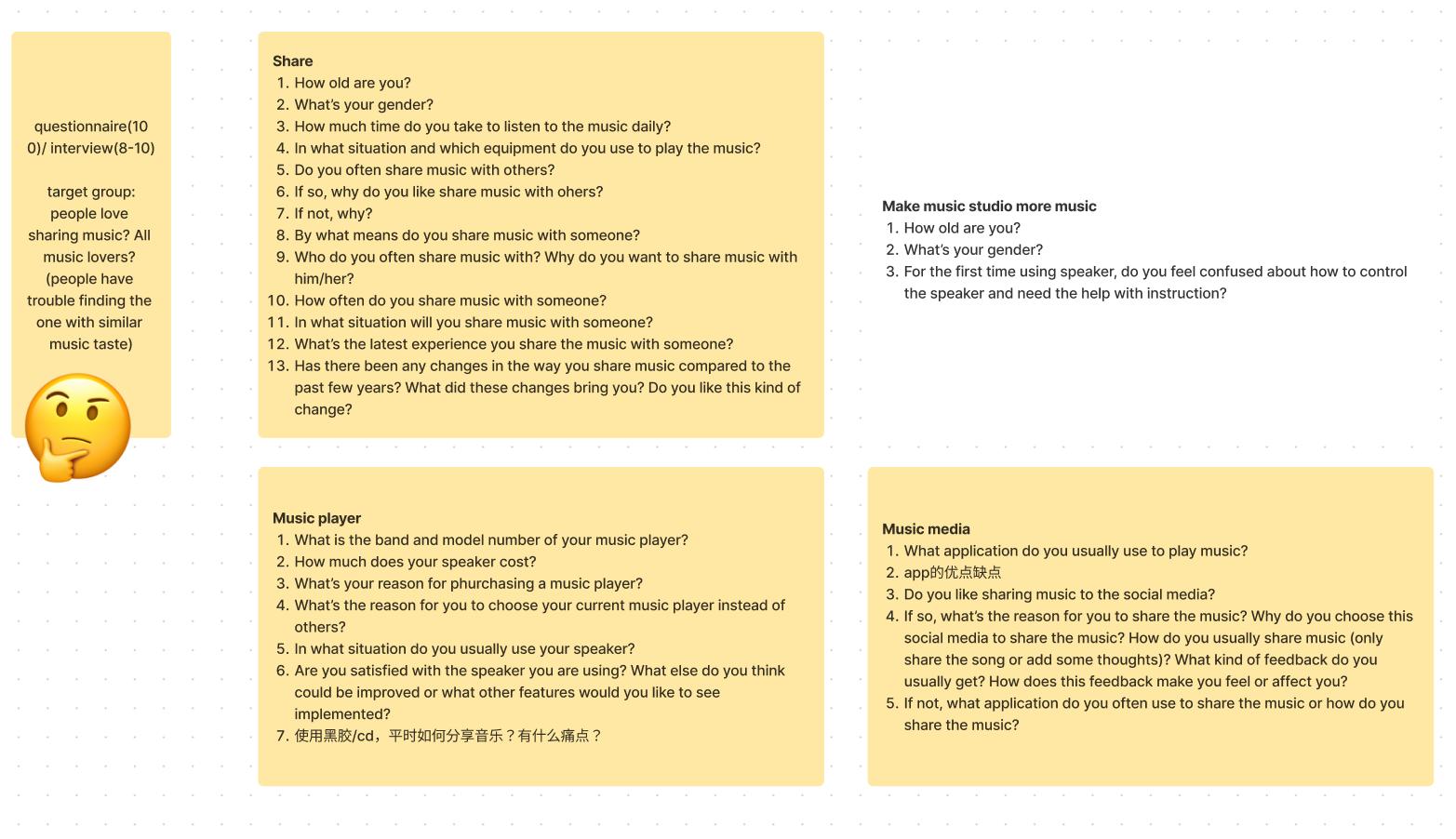
User test interview questions for exploring the current music sharing experience
Consent Form for exploring the current music sharing experience
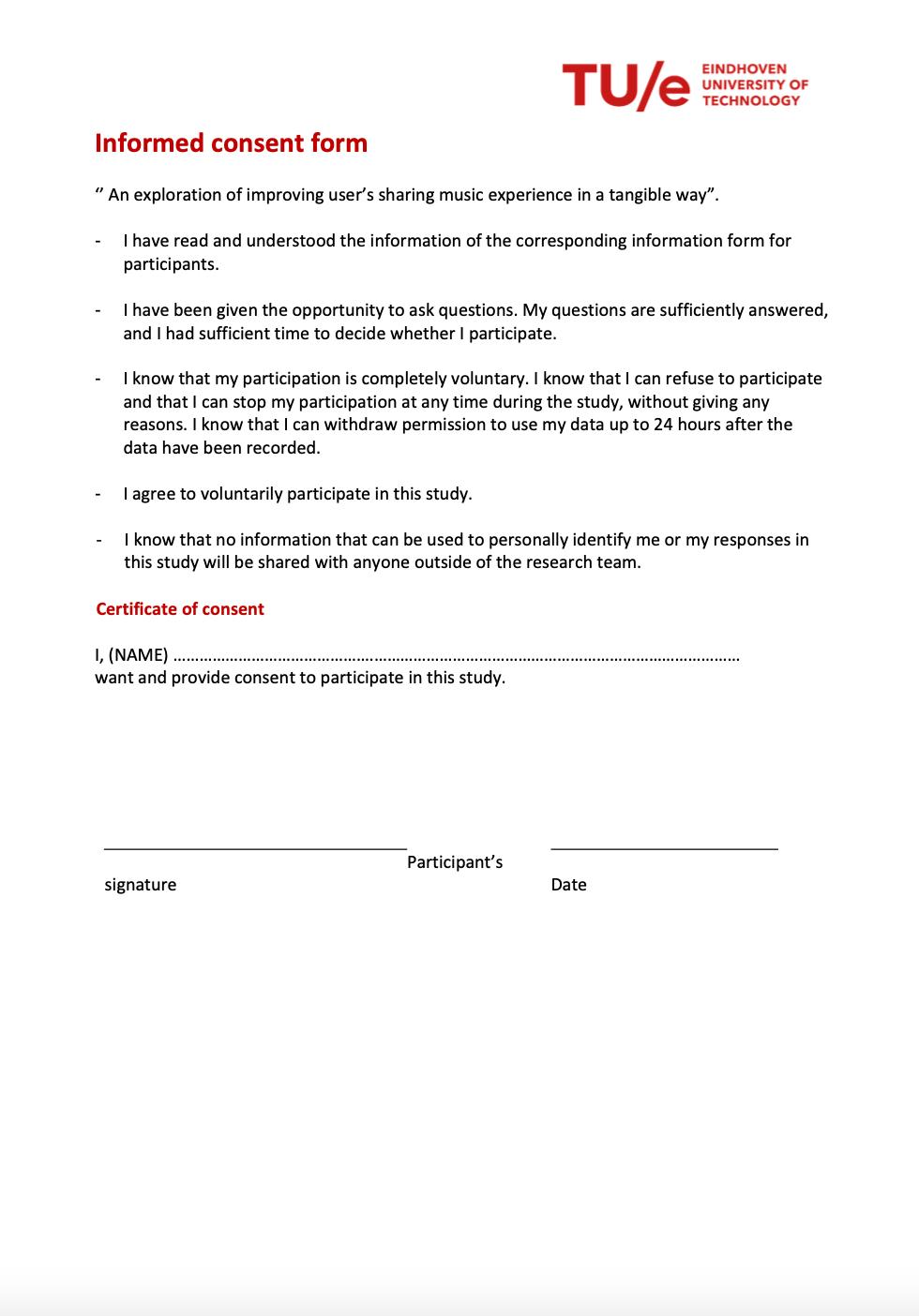
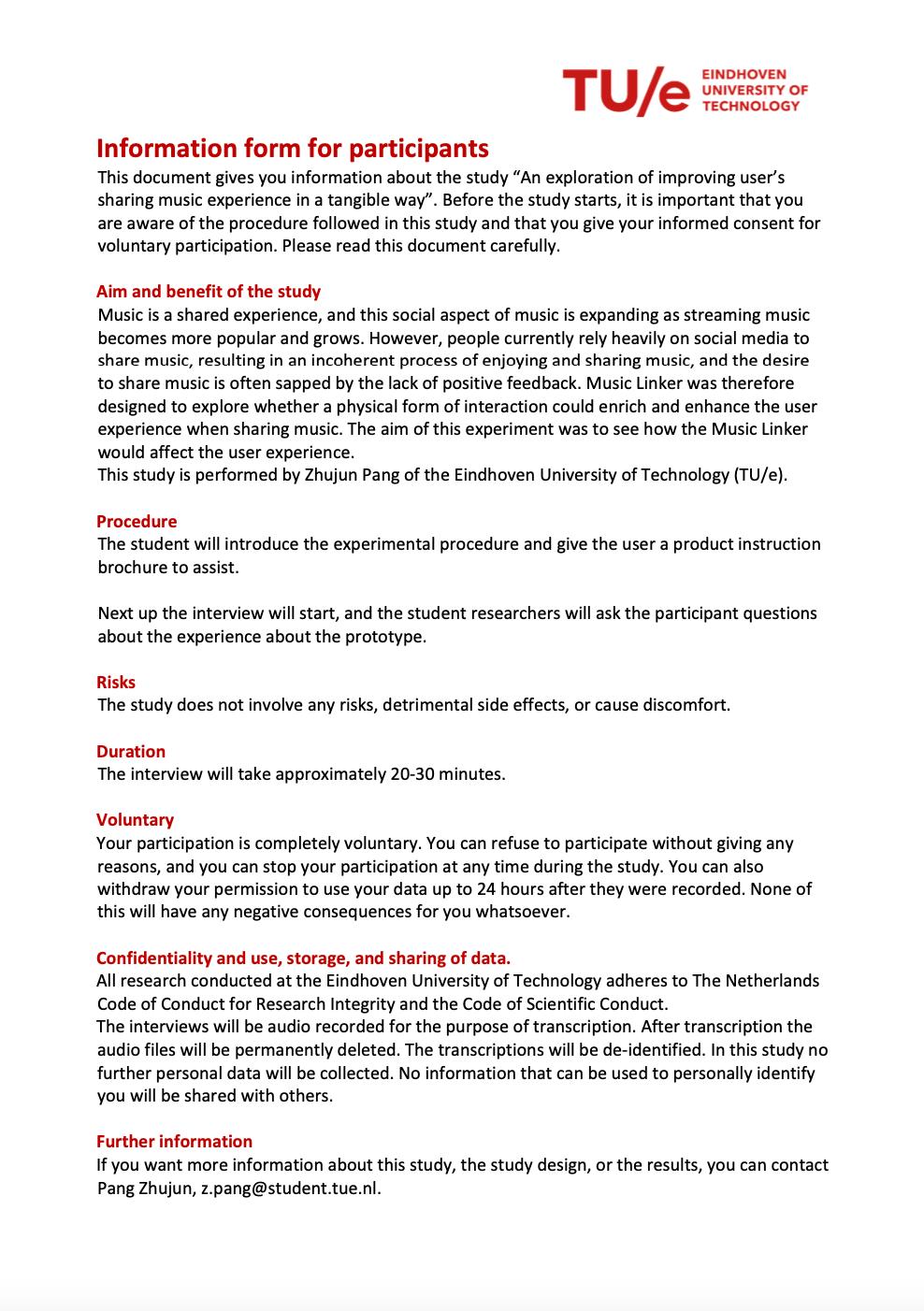
Music Linker -M2.1 design project Music Linker -M2.1 design project 56 57
APPENDIX C -User Test Materials
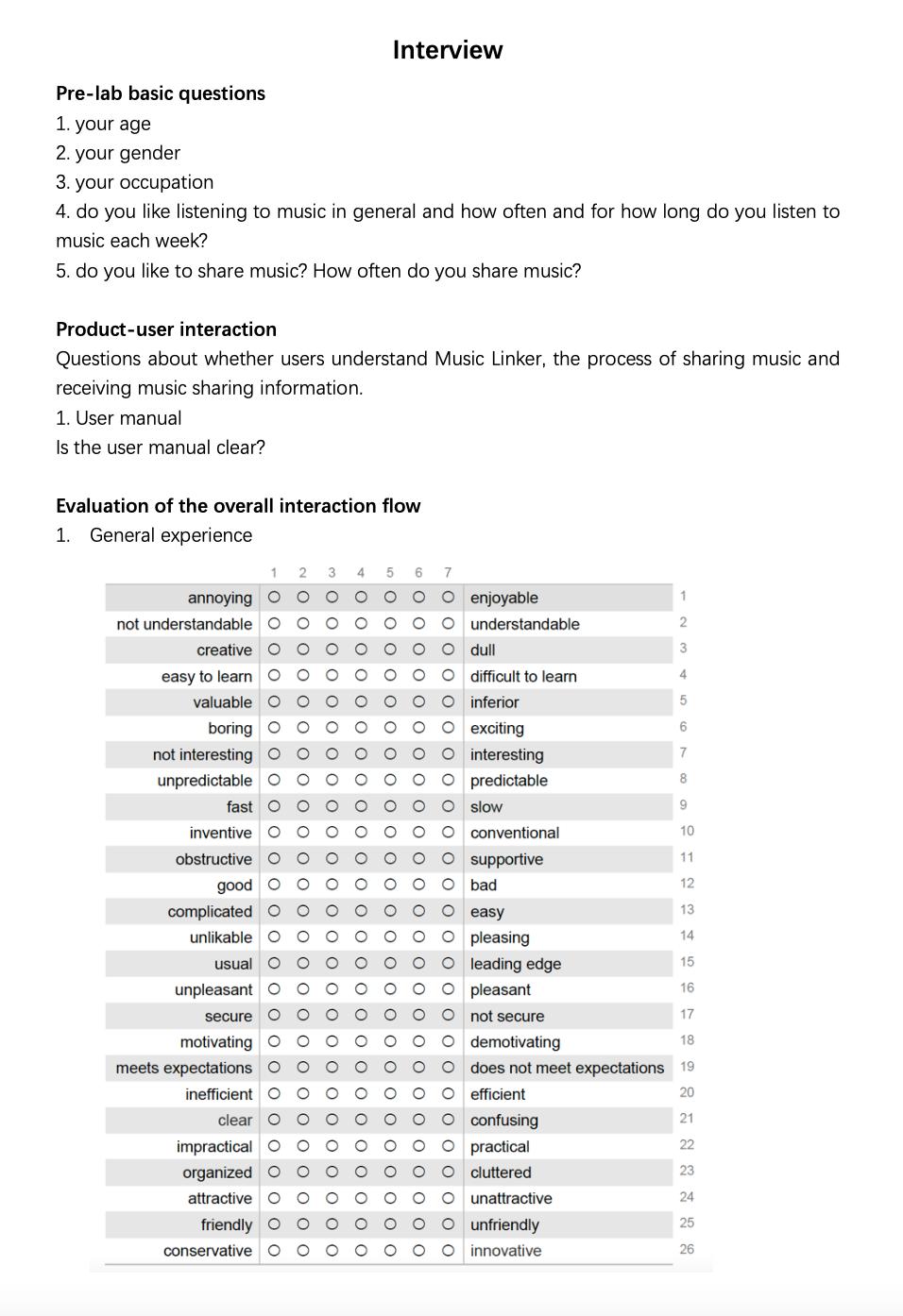
User test interview questions for final prototype
Consent Form for final prototype
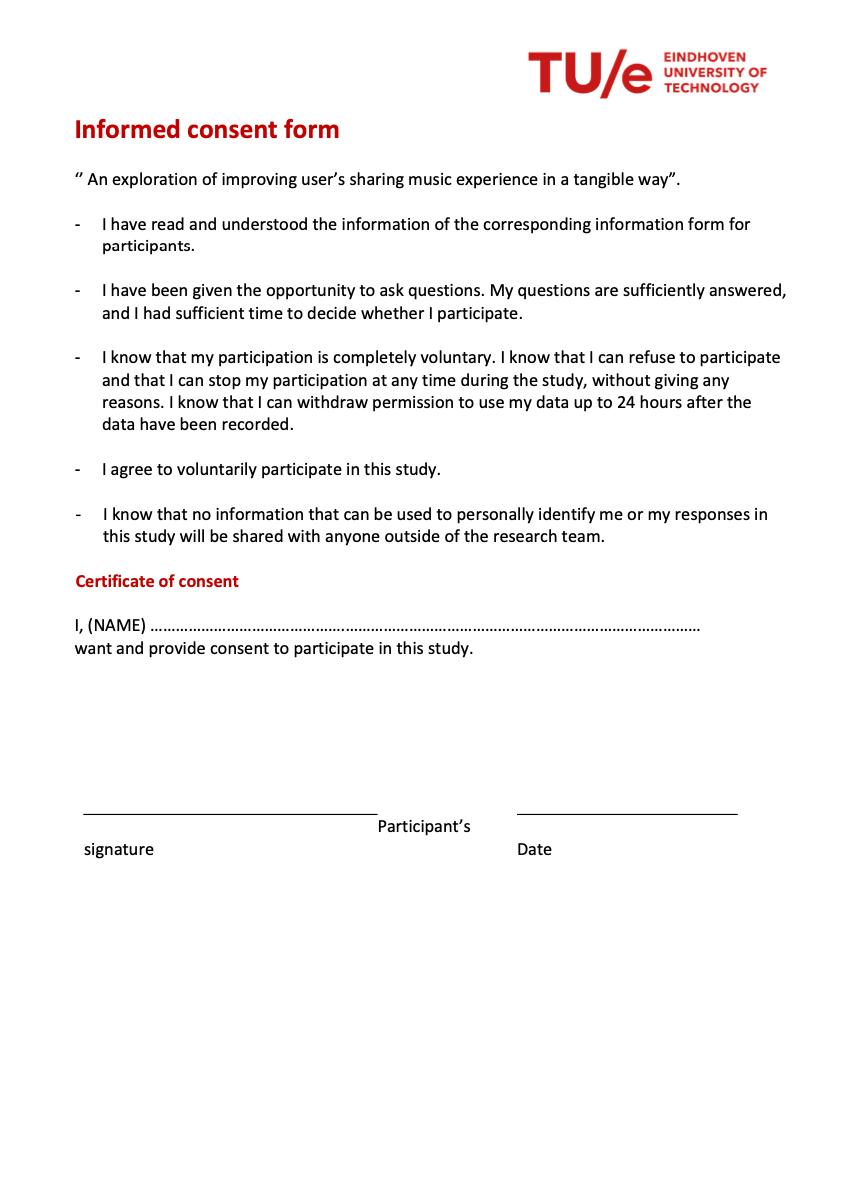

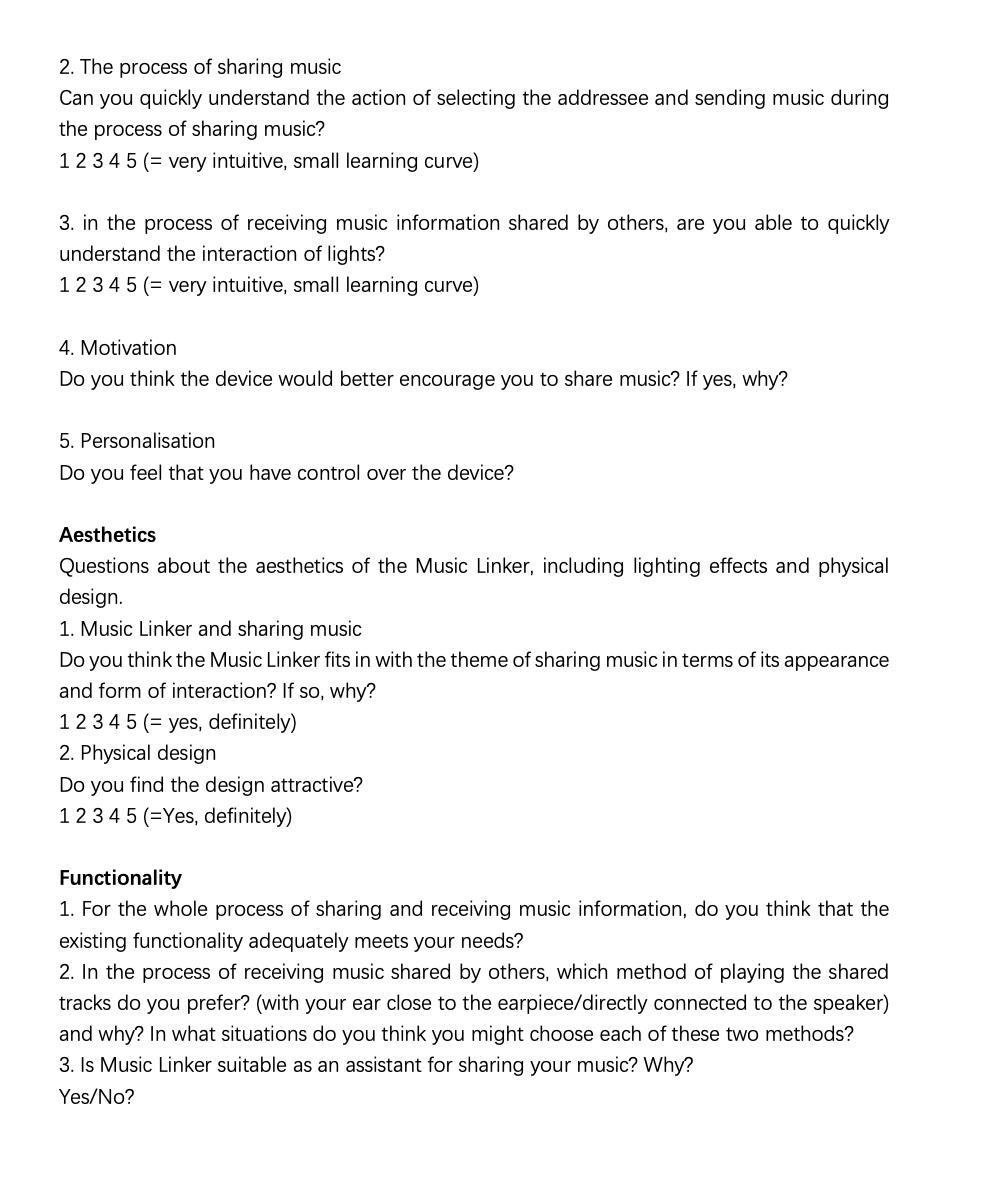
Music Linker -M2.1 design project Music Linker -M2.1 design project 58 59
APPENDIX C -User Test
Materials
User test interaction flow for final prototype
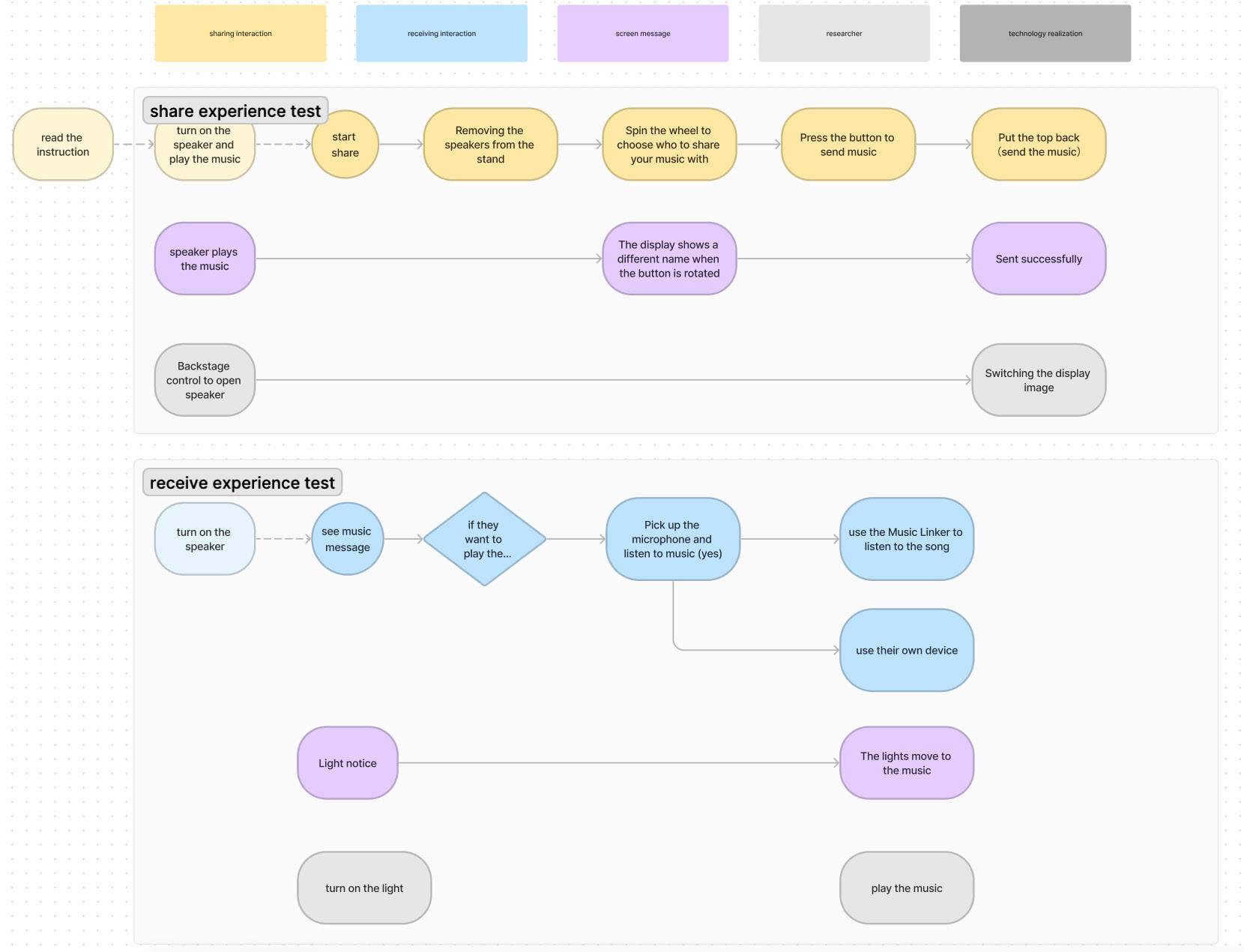
Music Linker -M2.1 design project Music Linker -M2.1 design project 60 61















































































